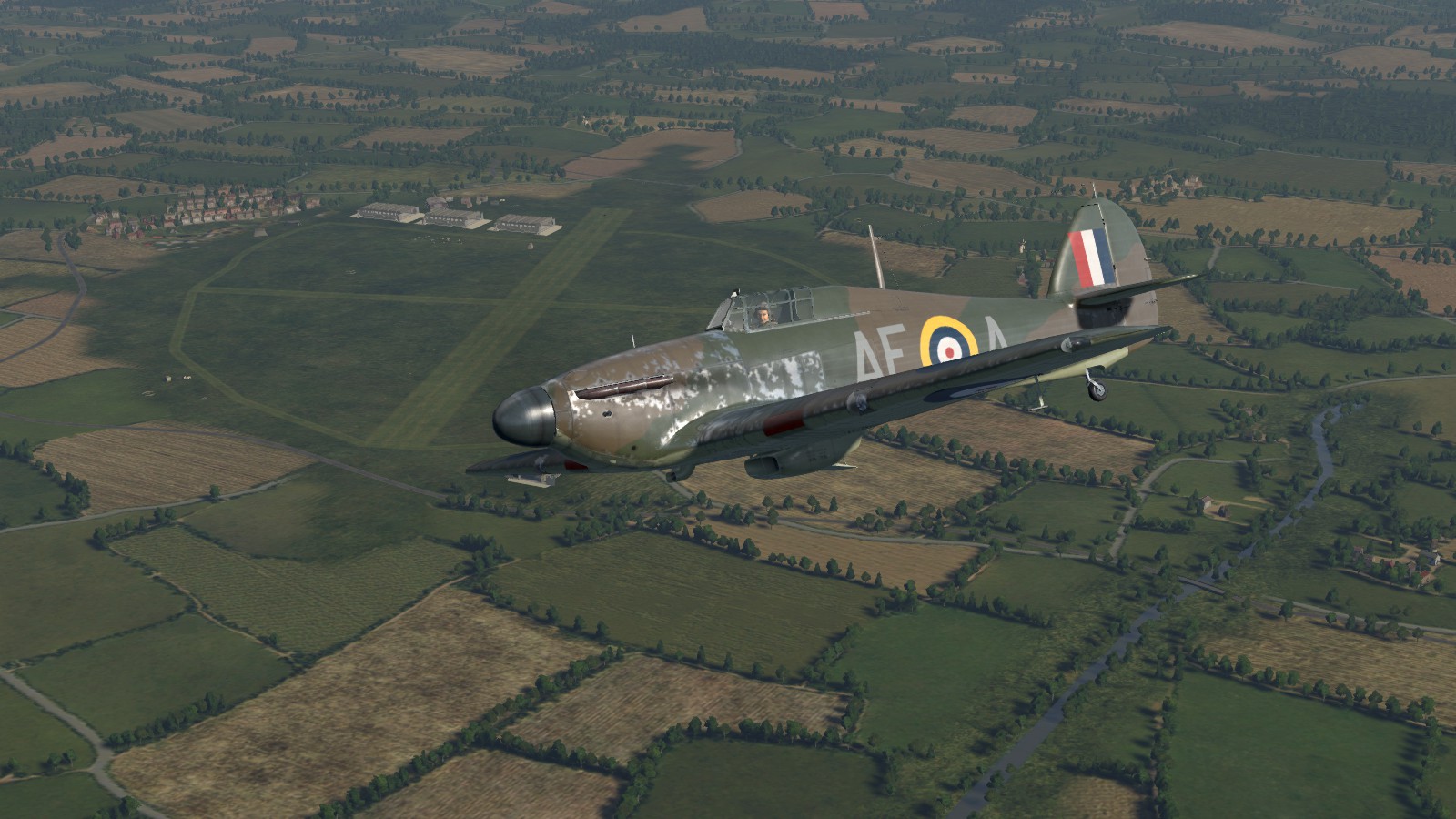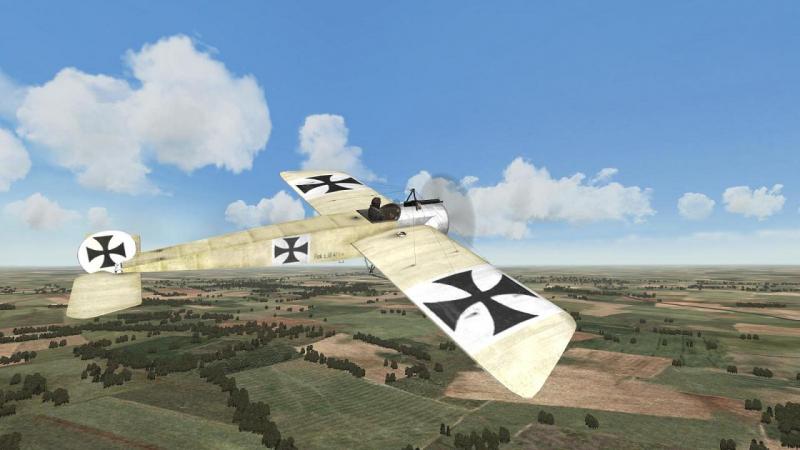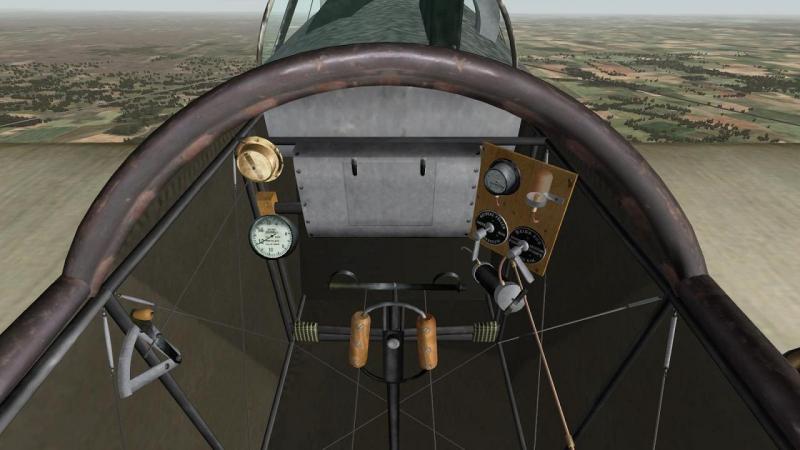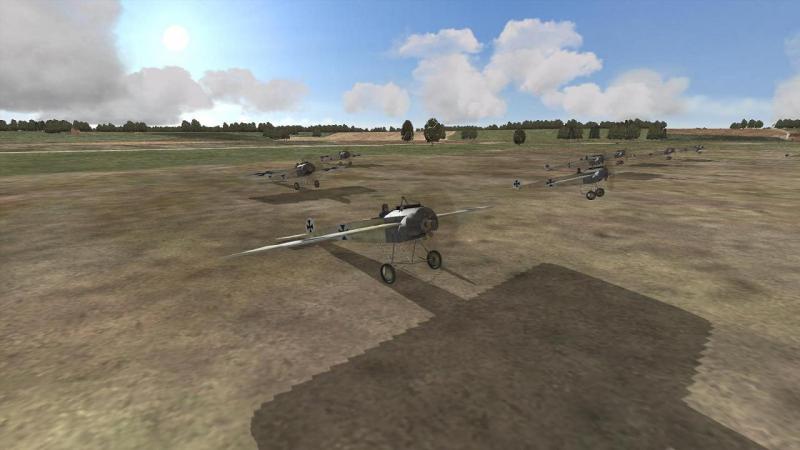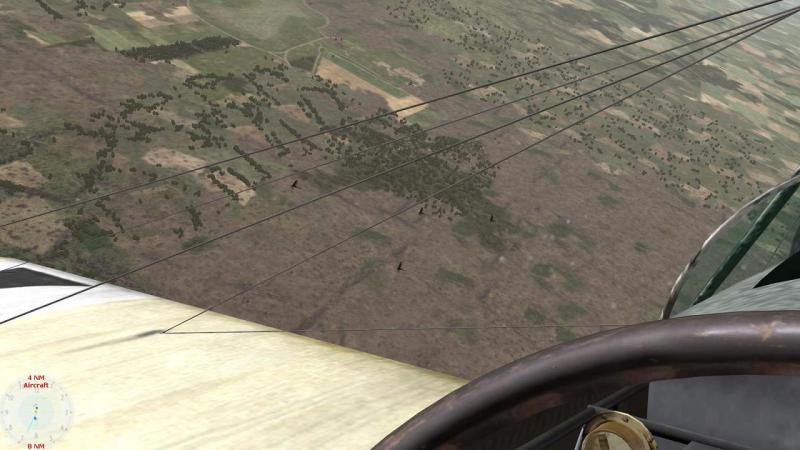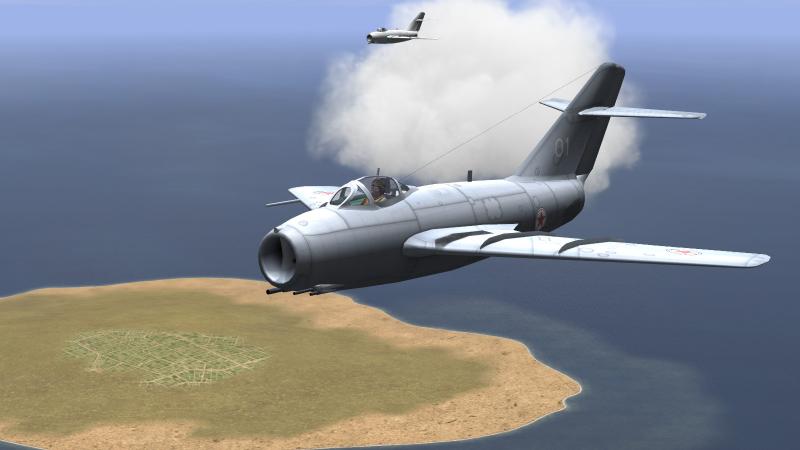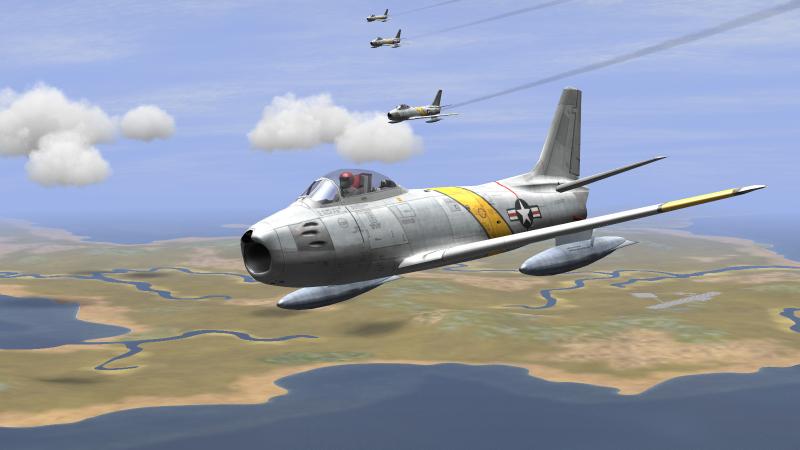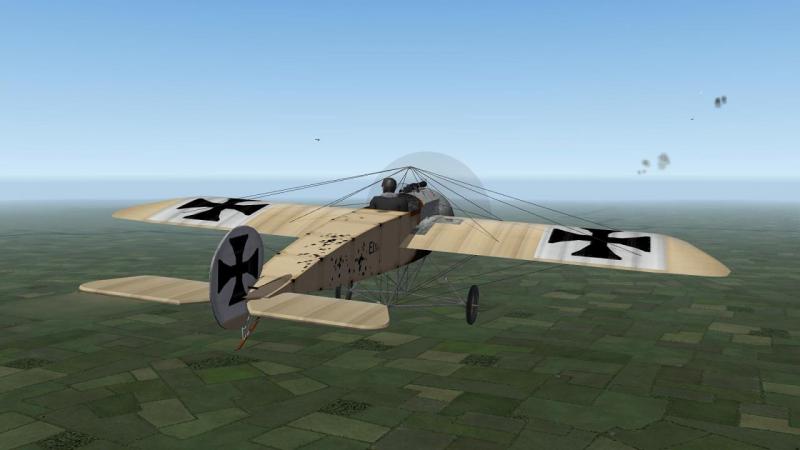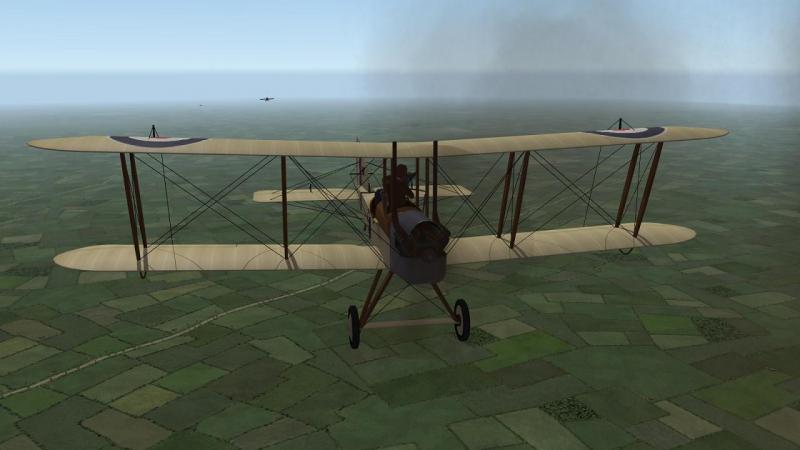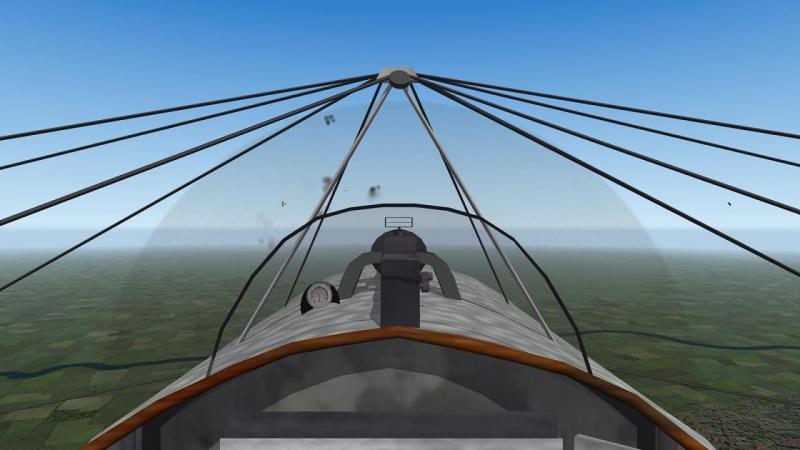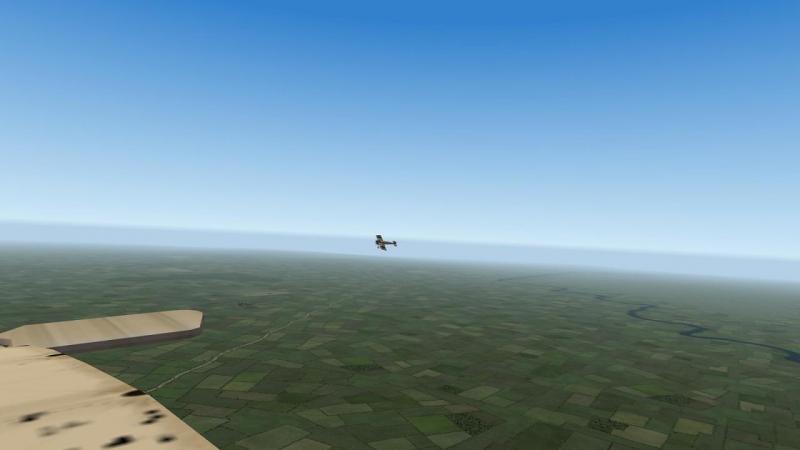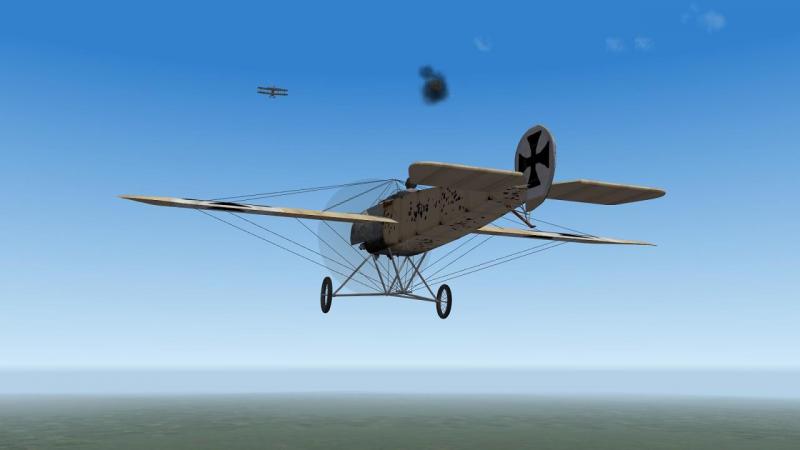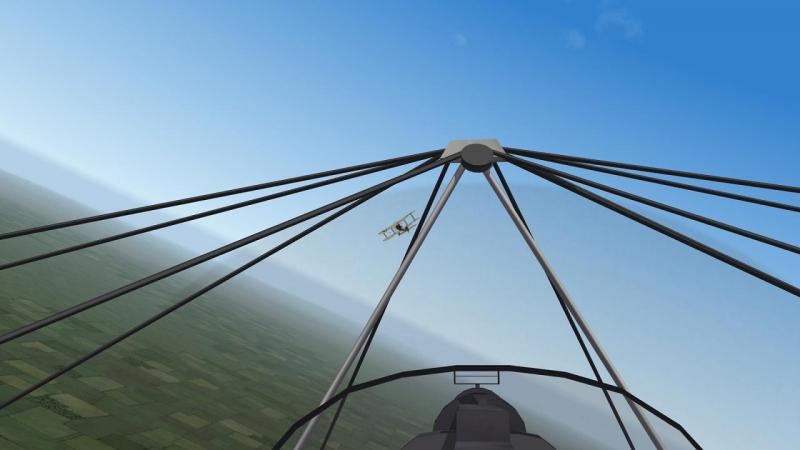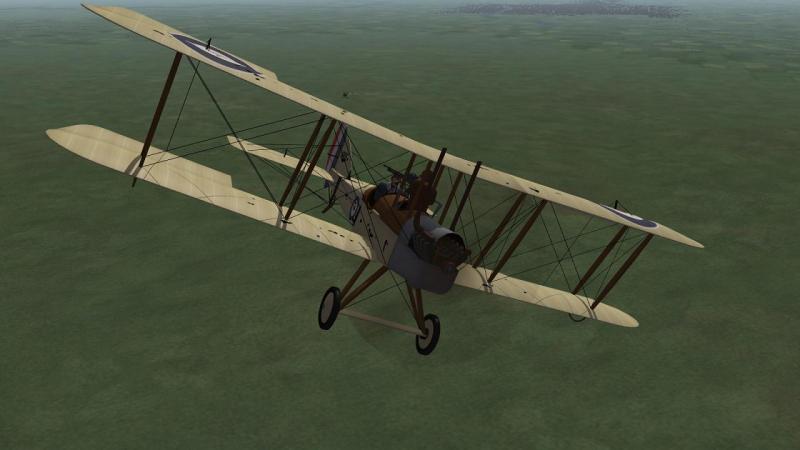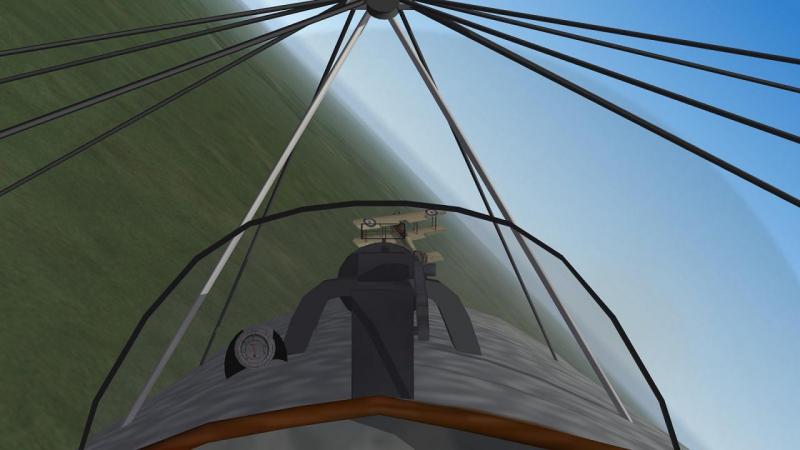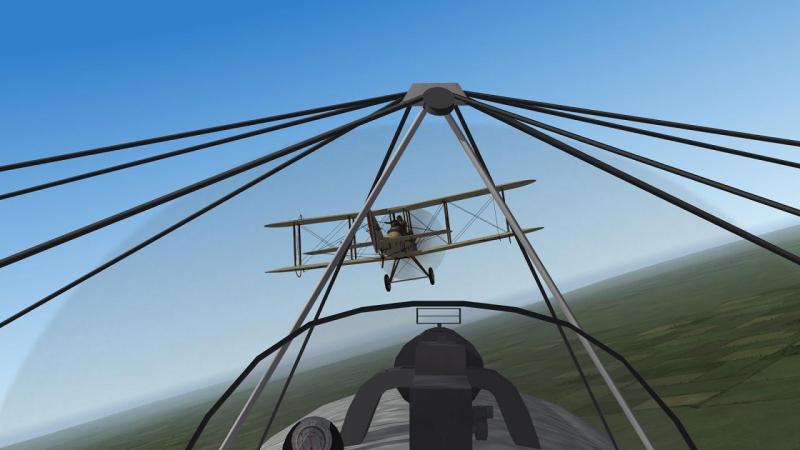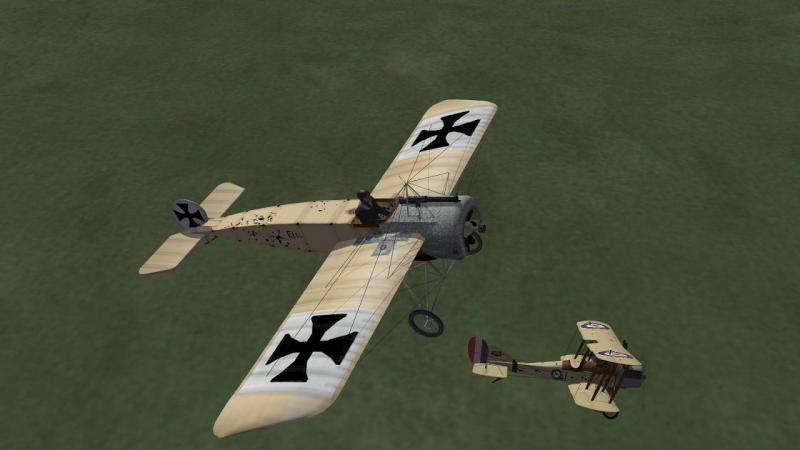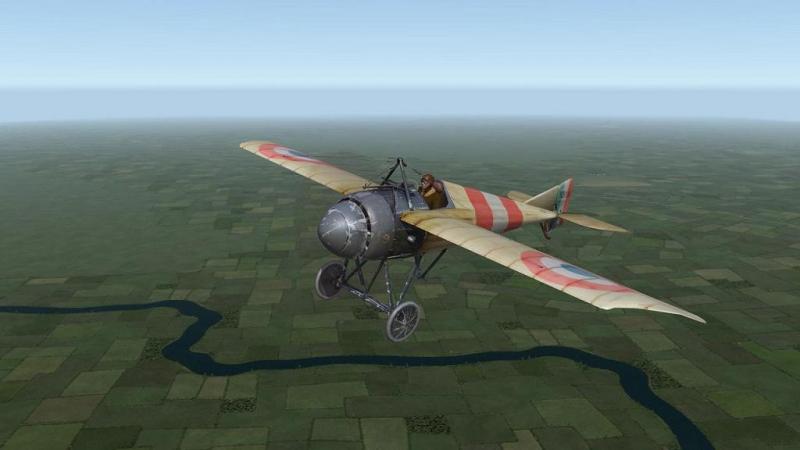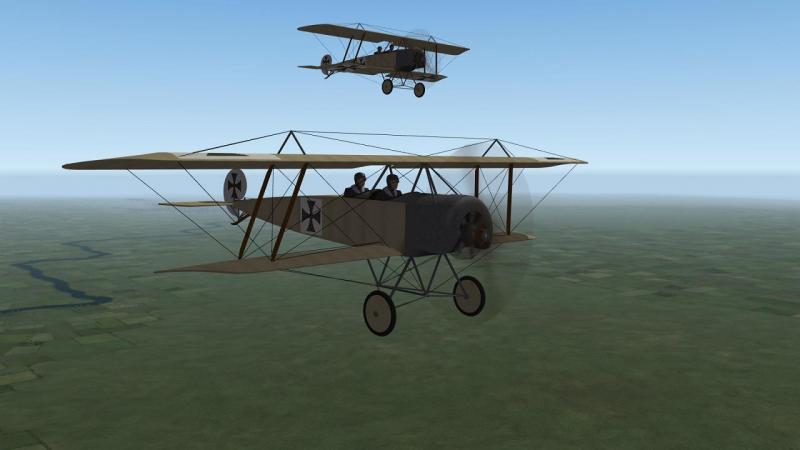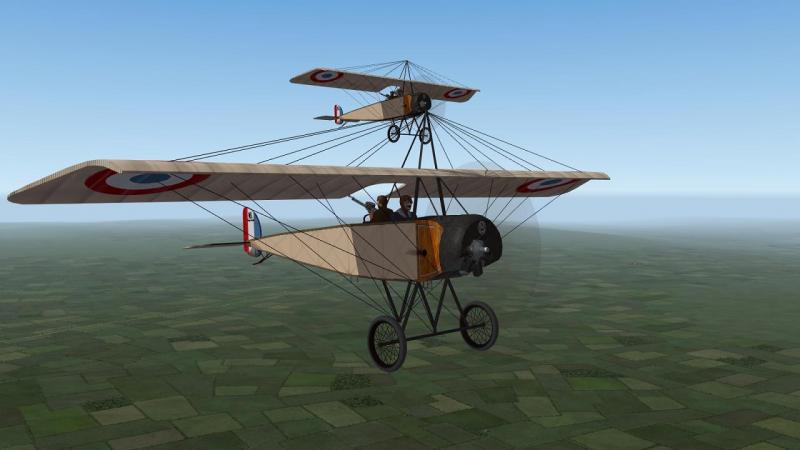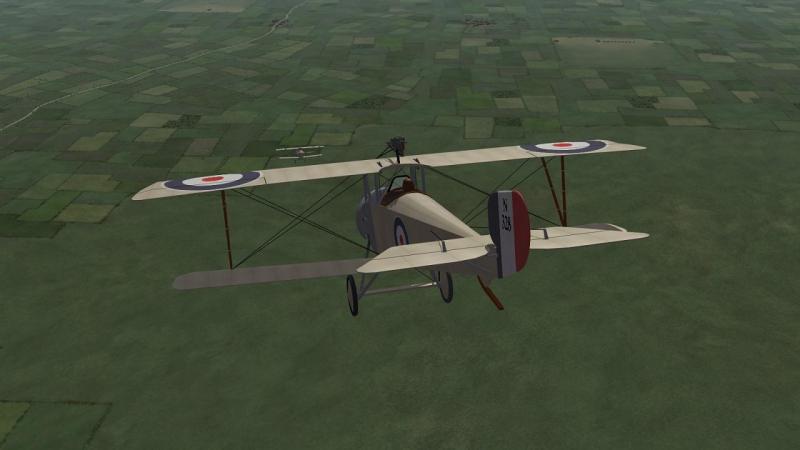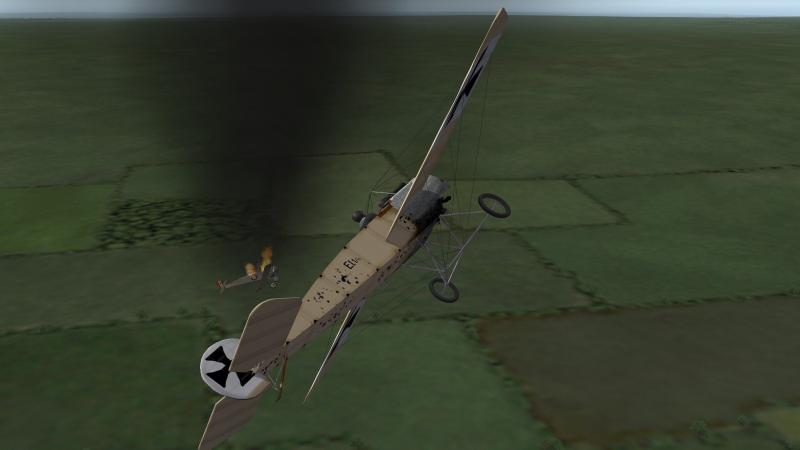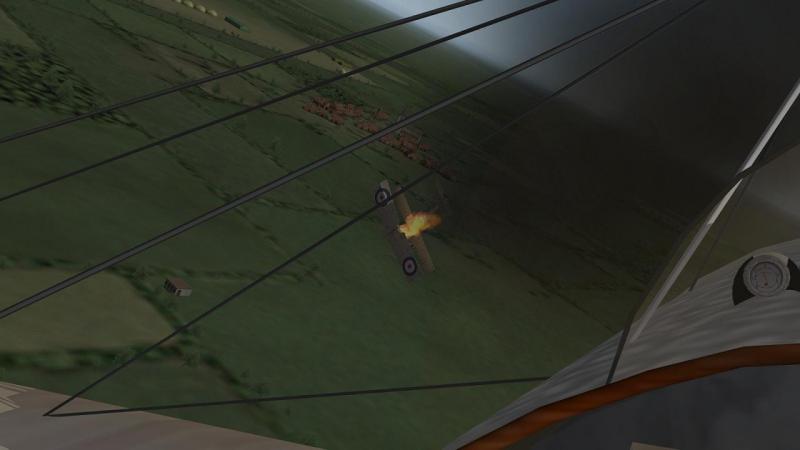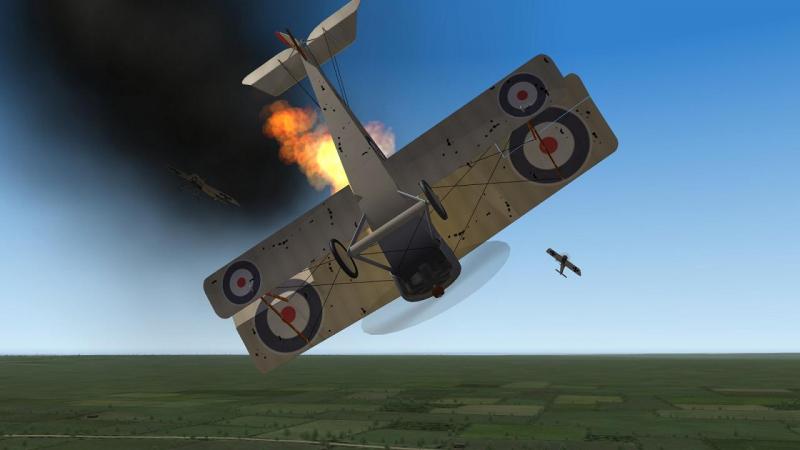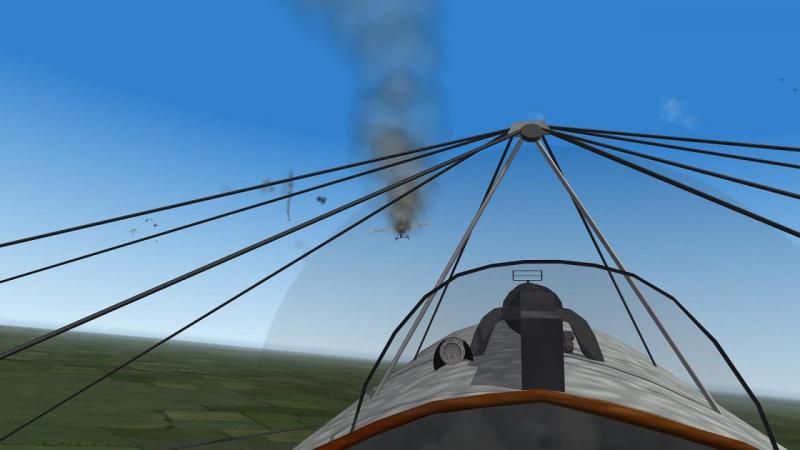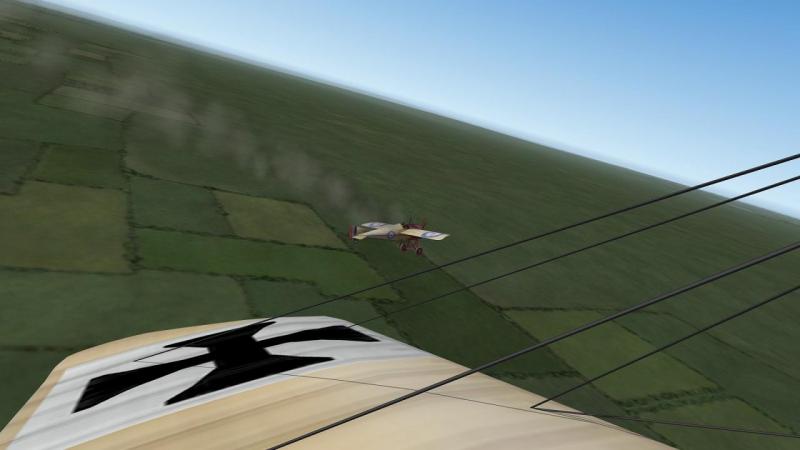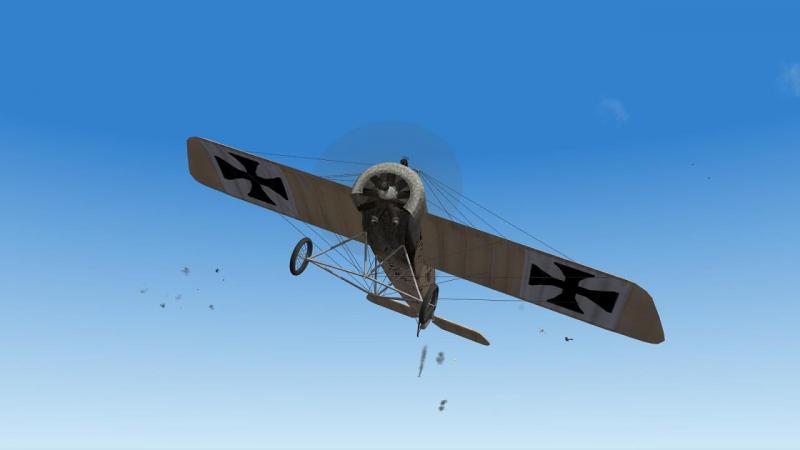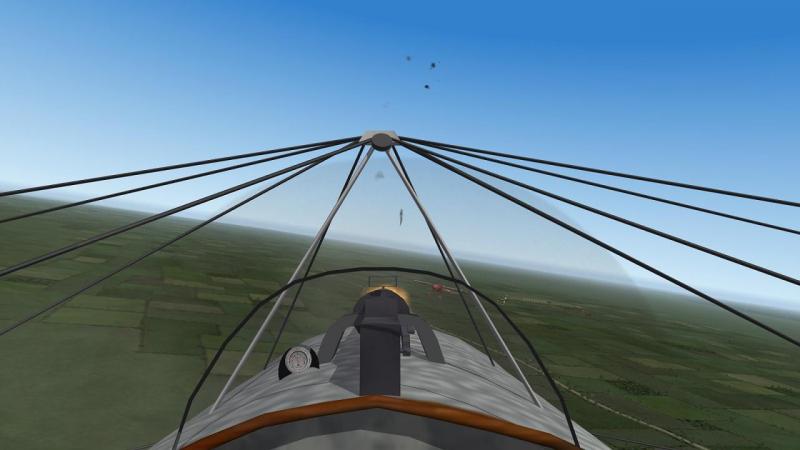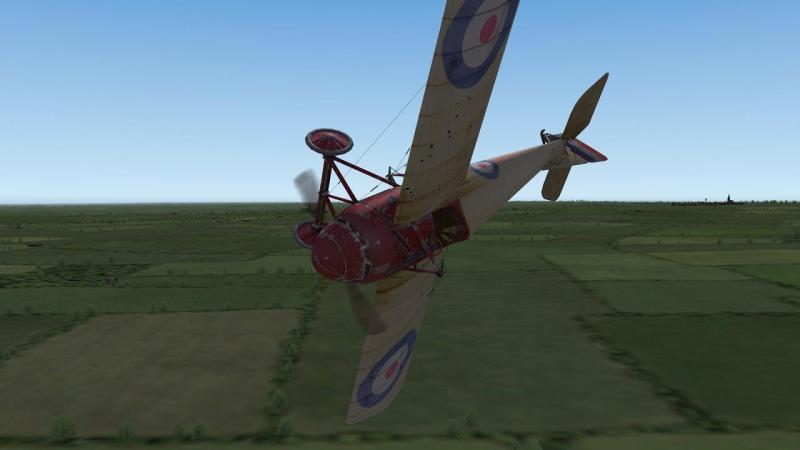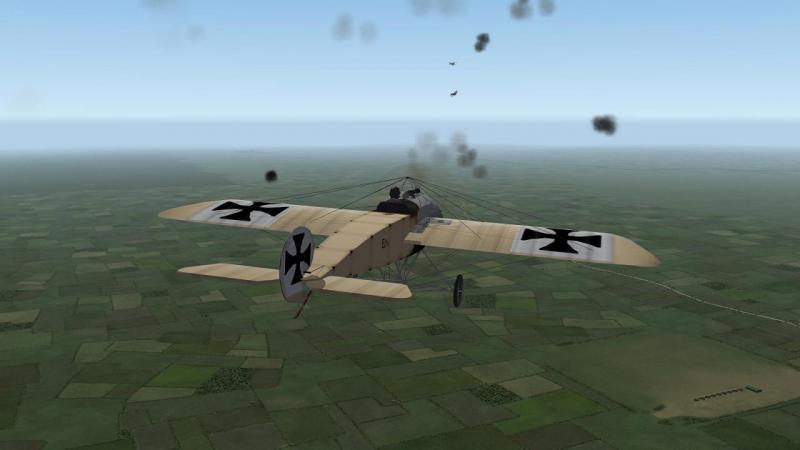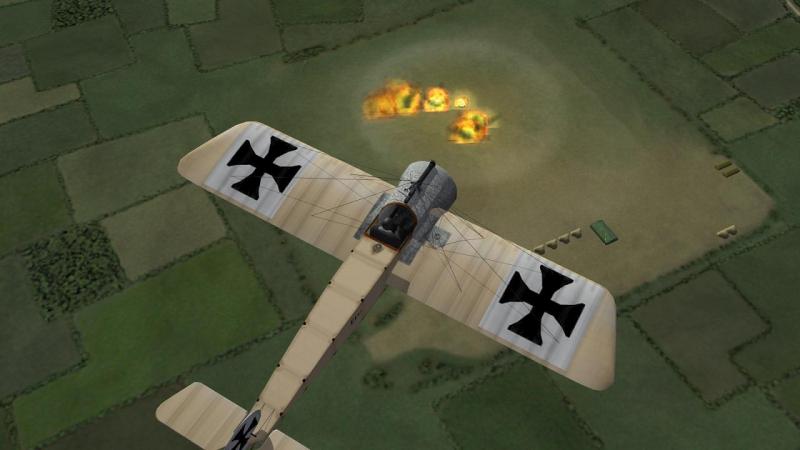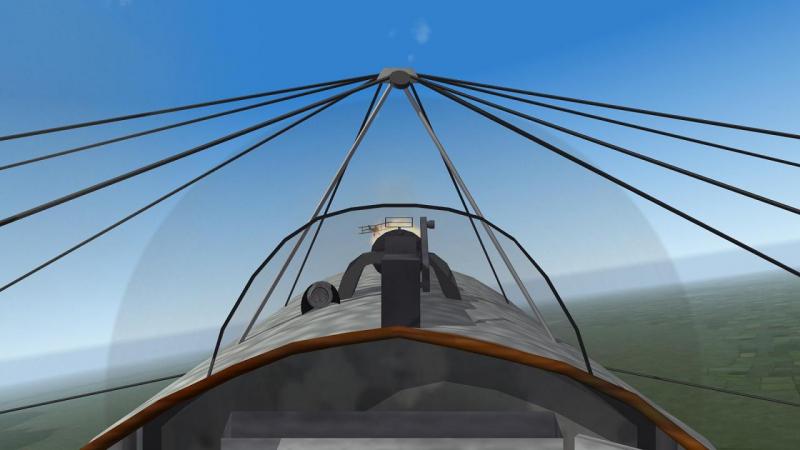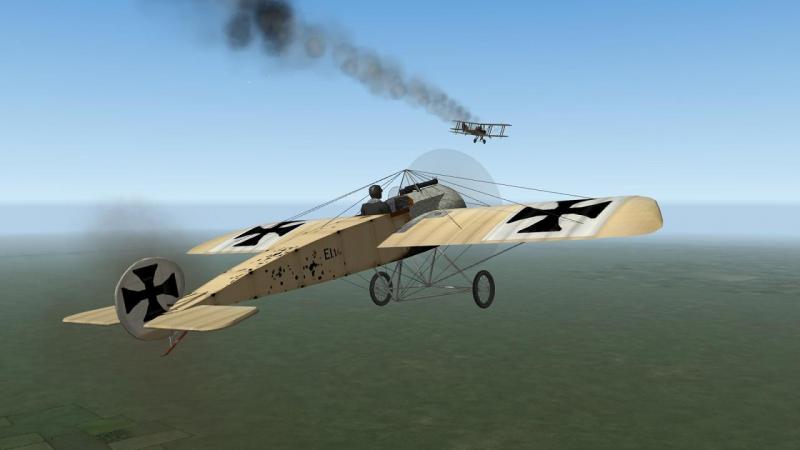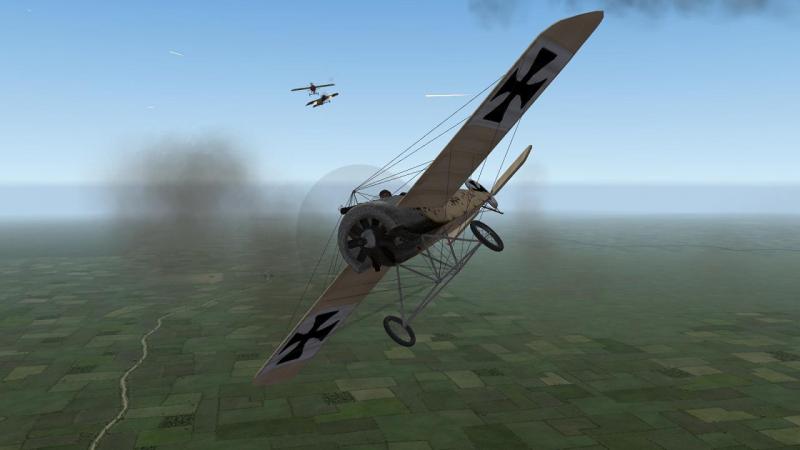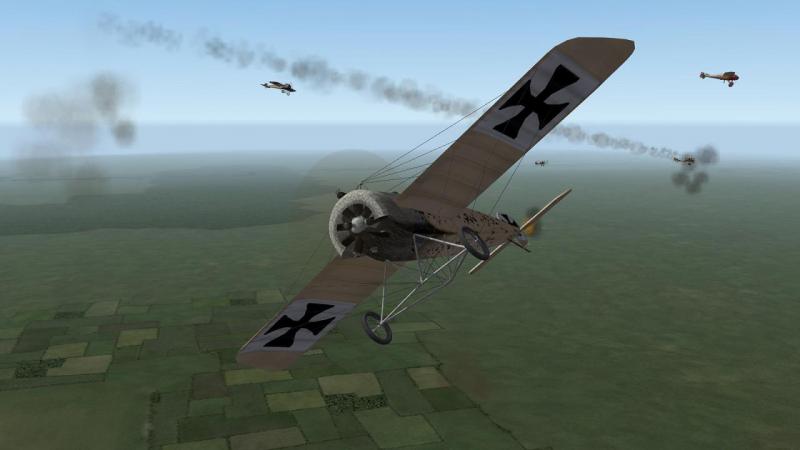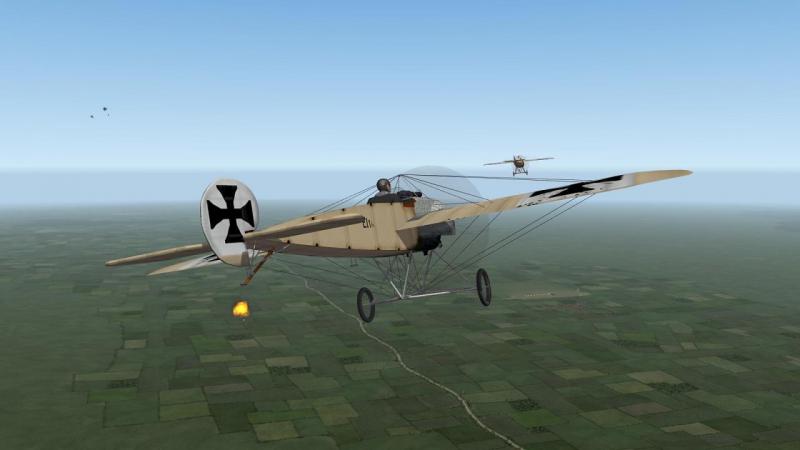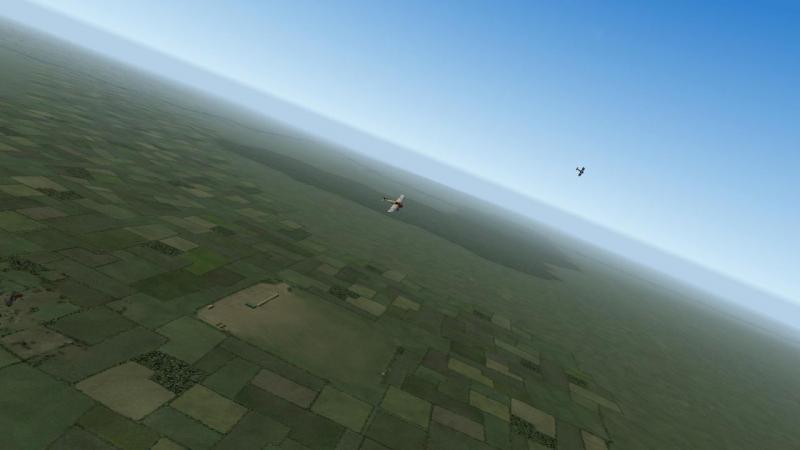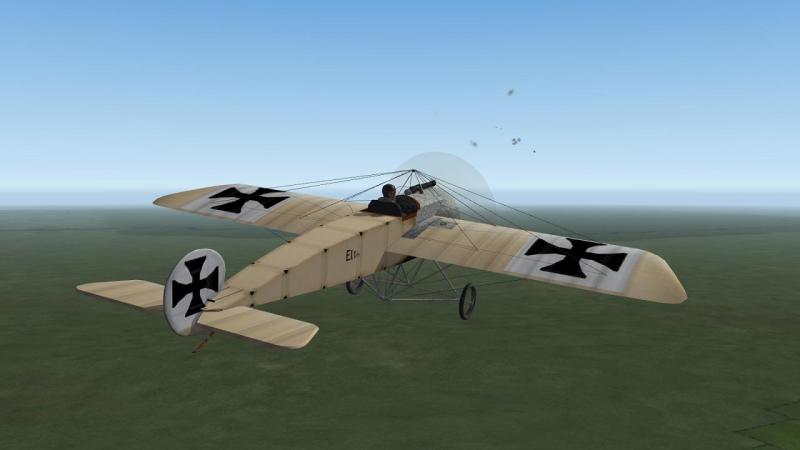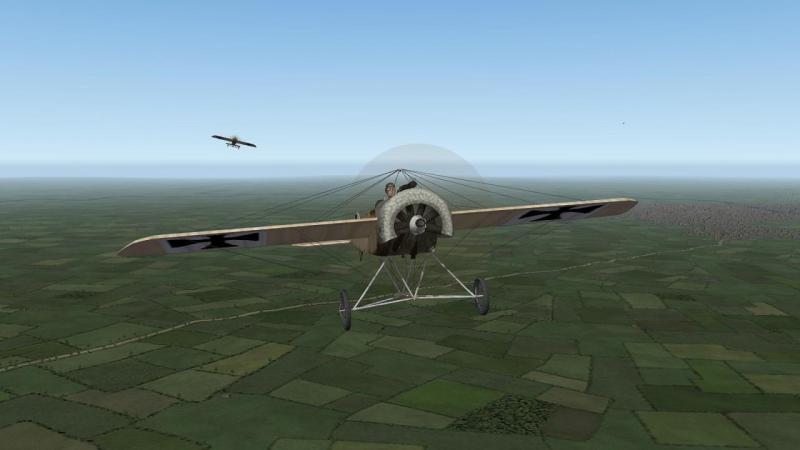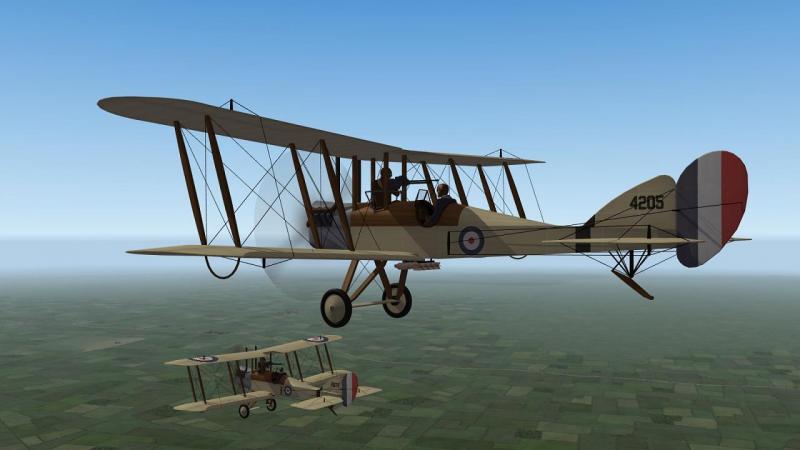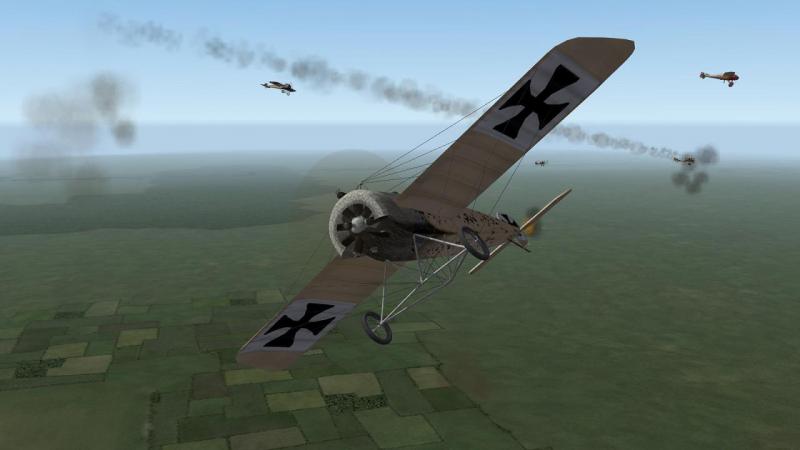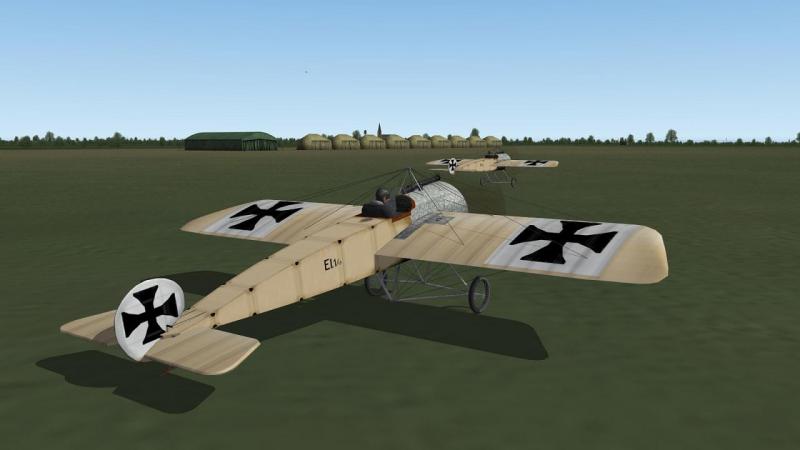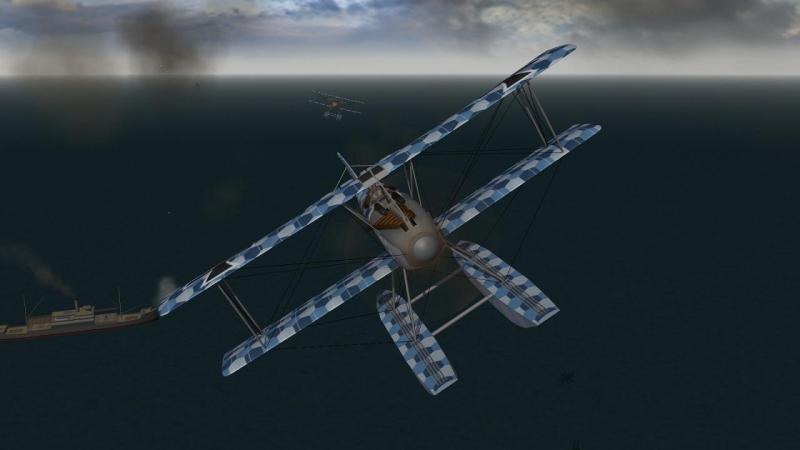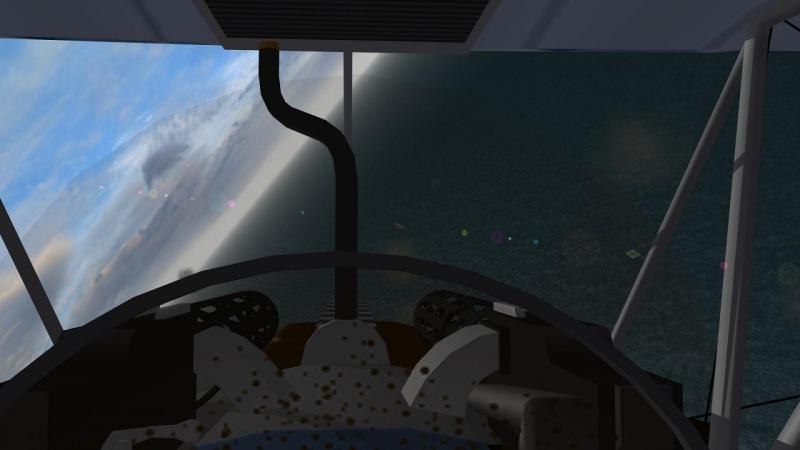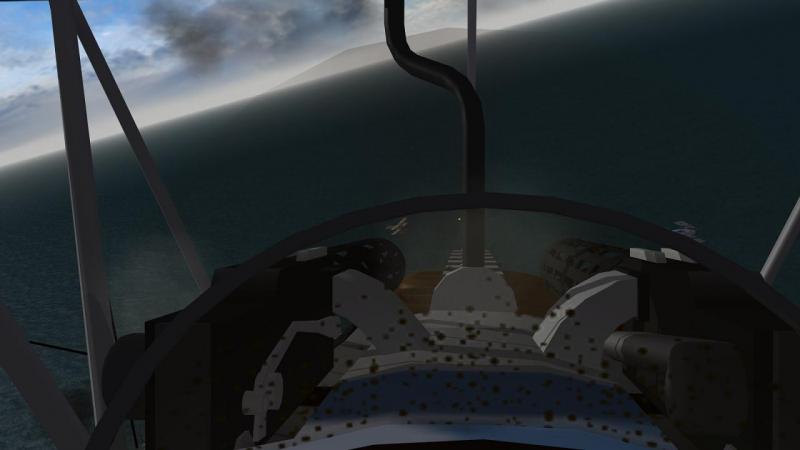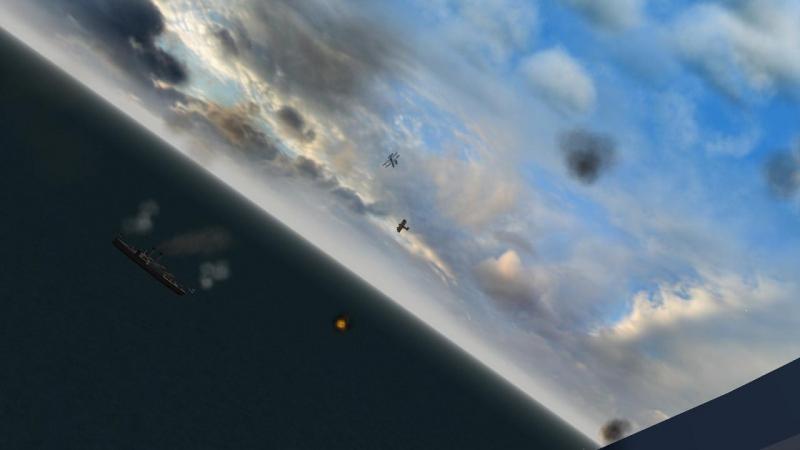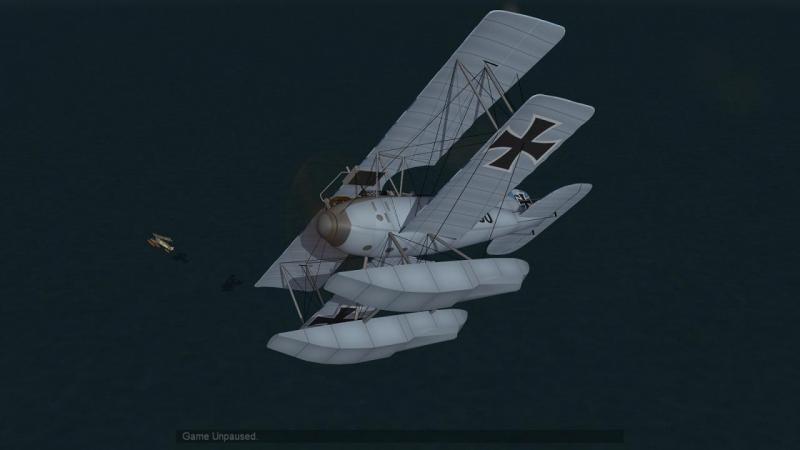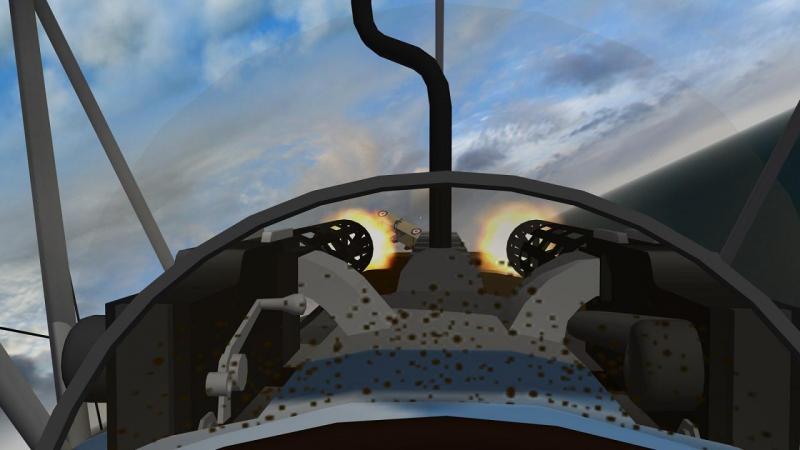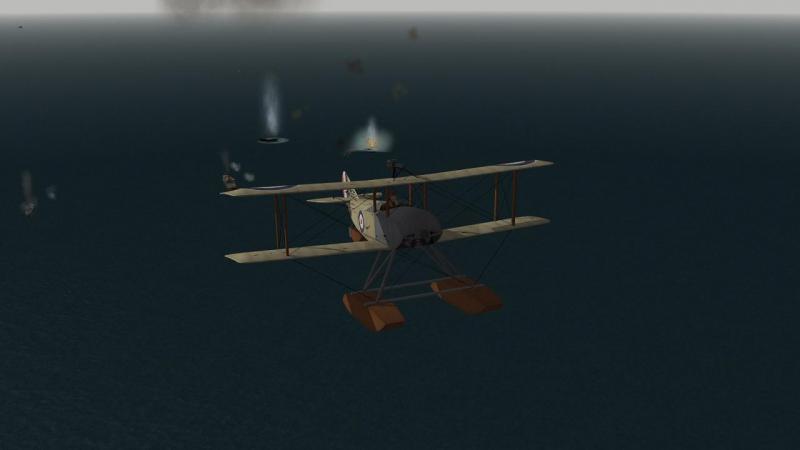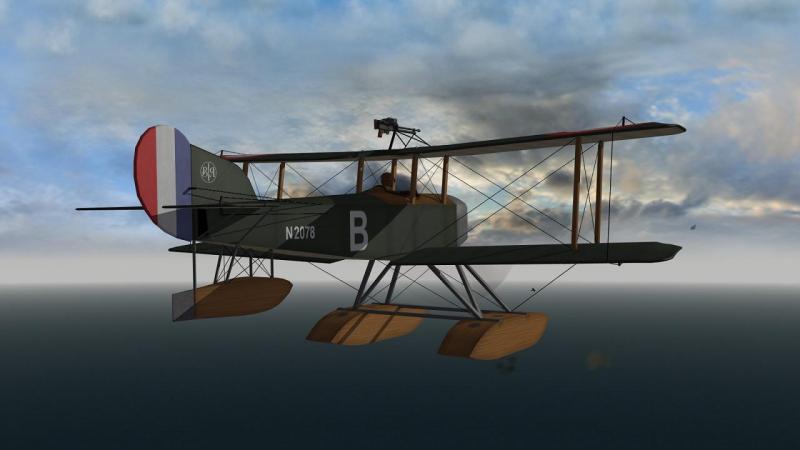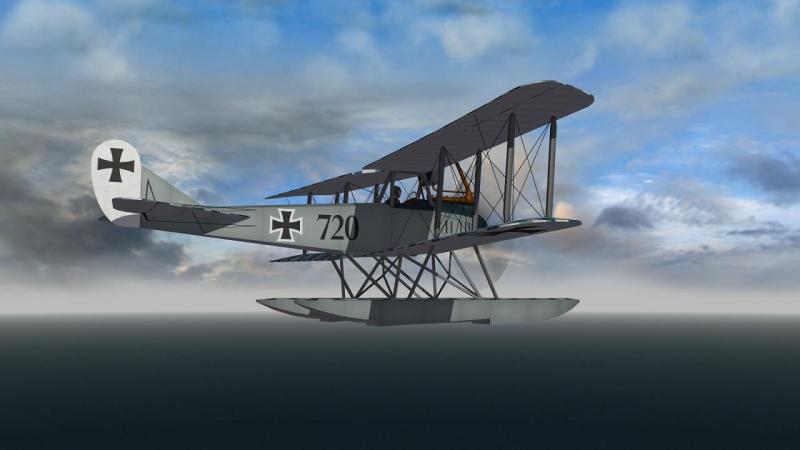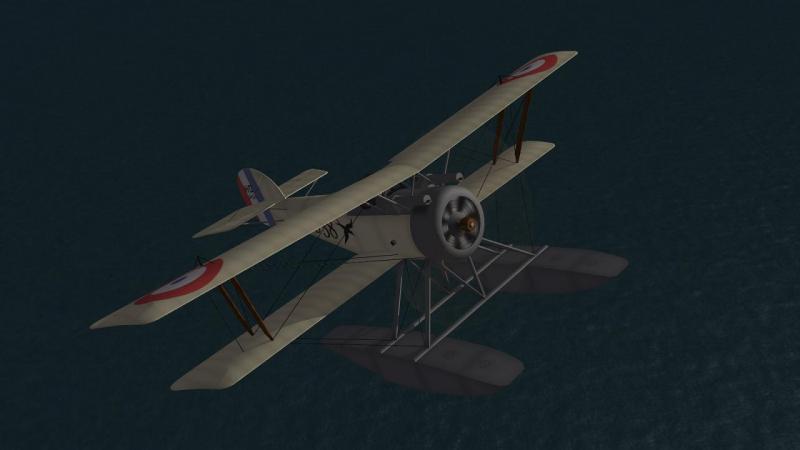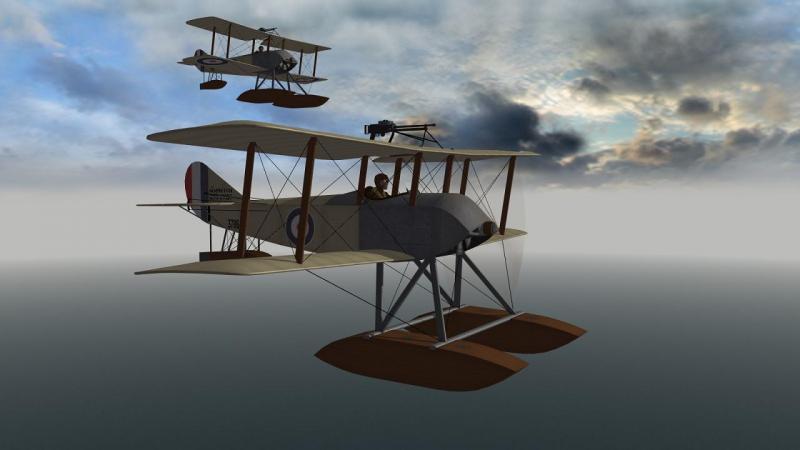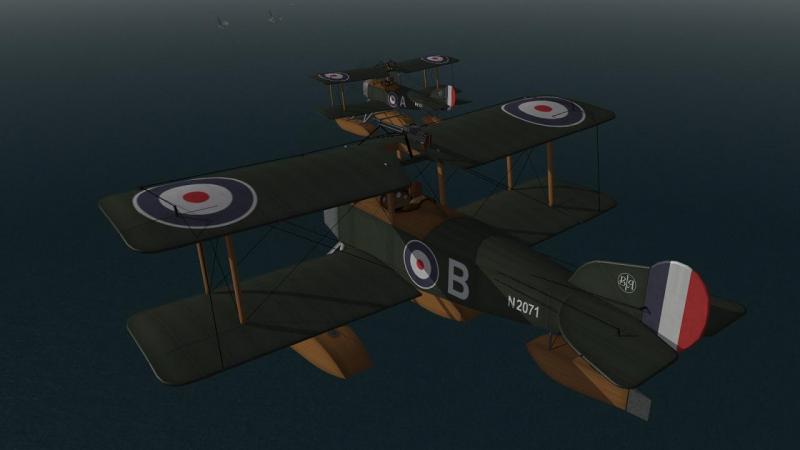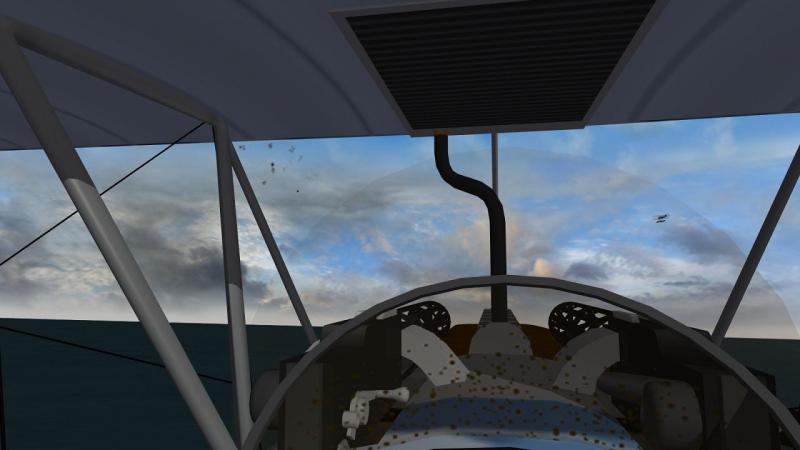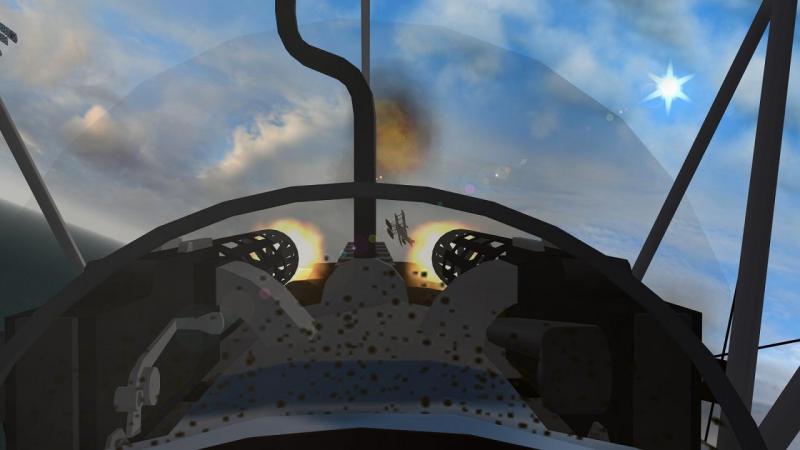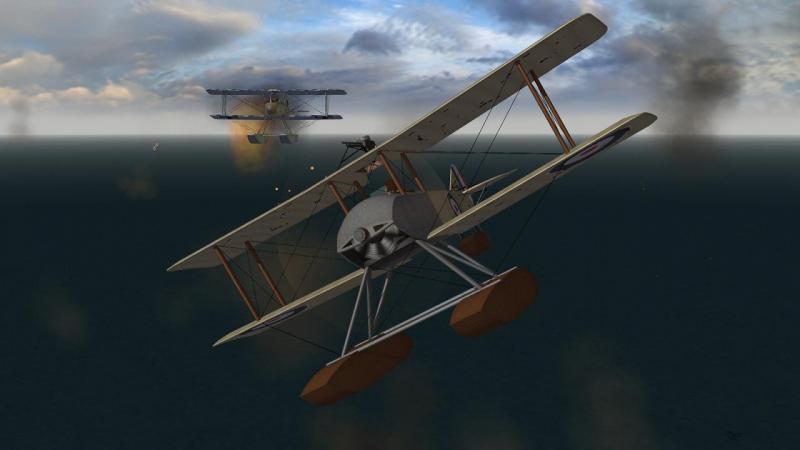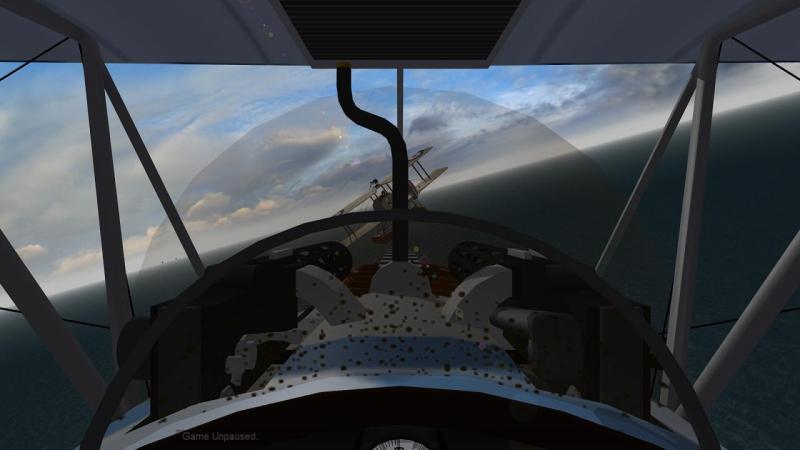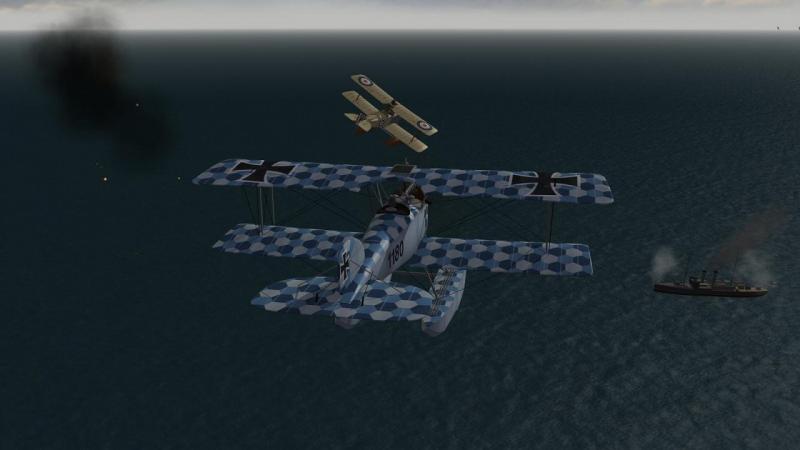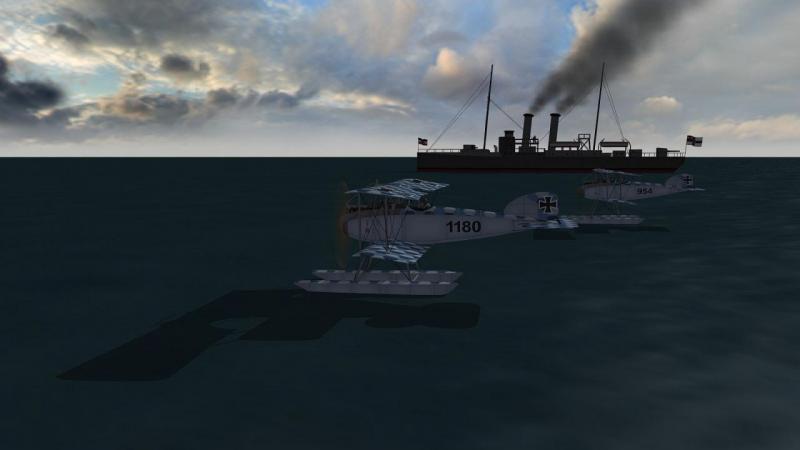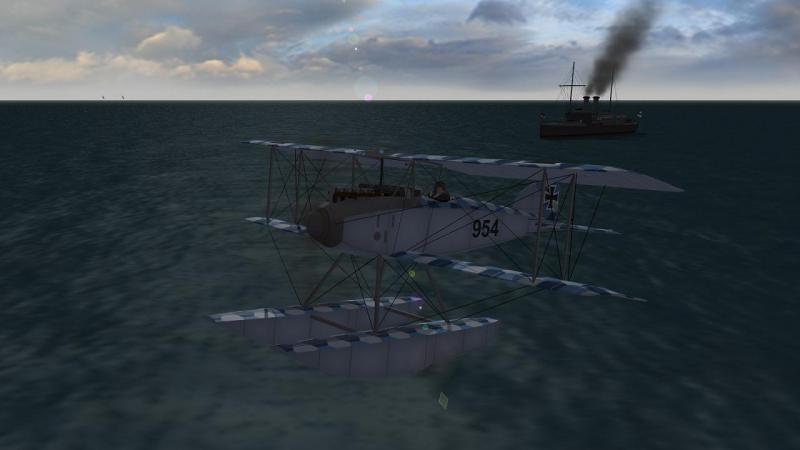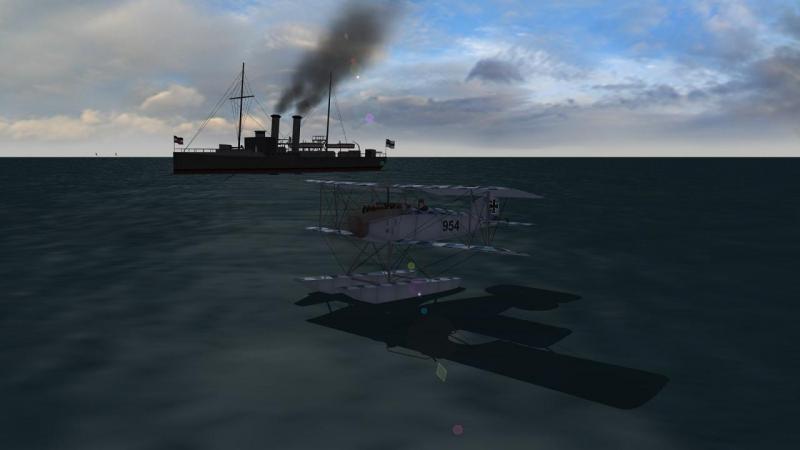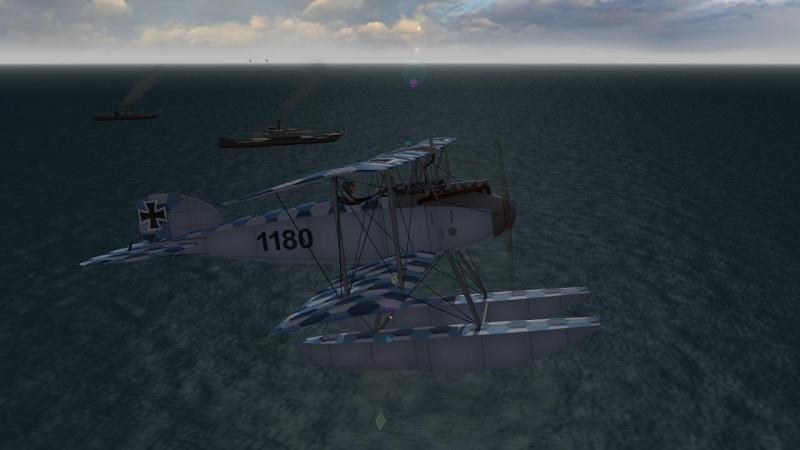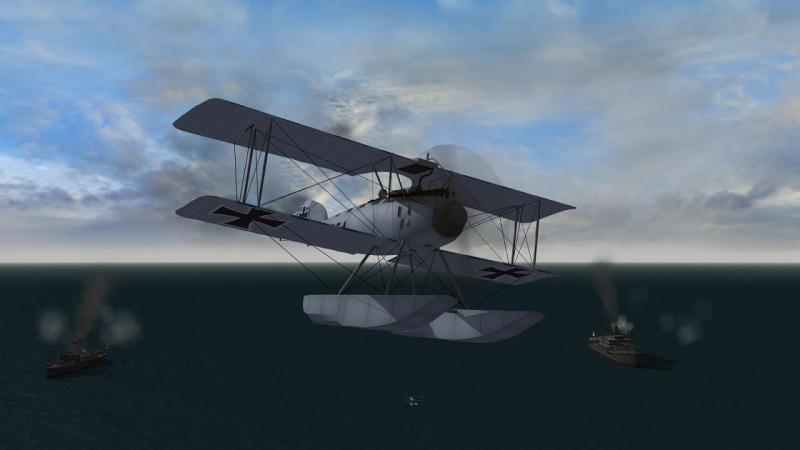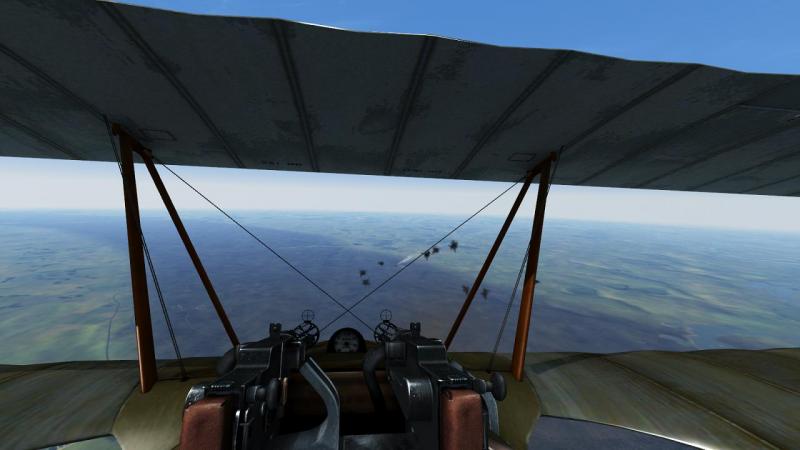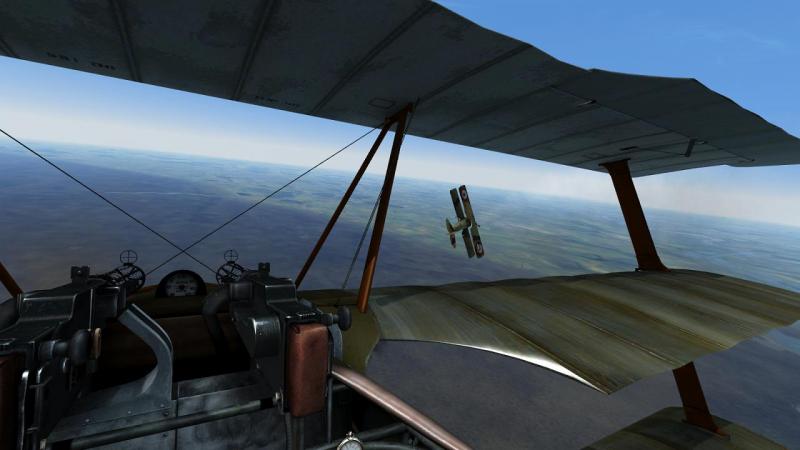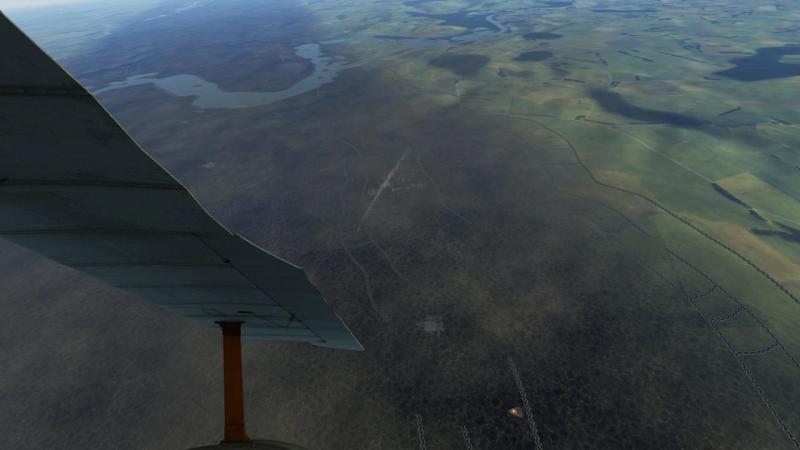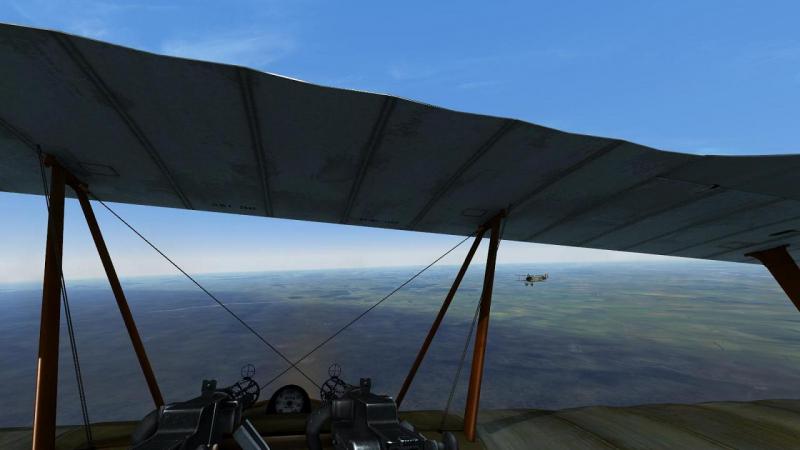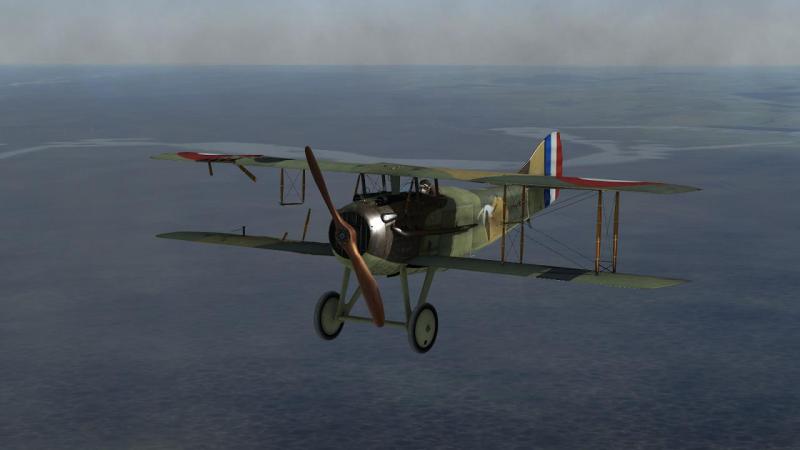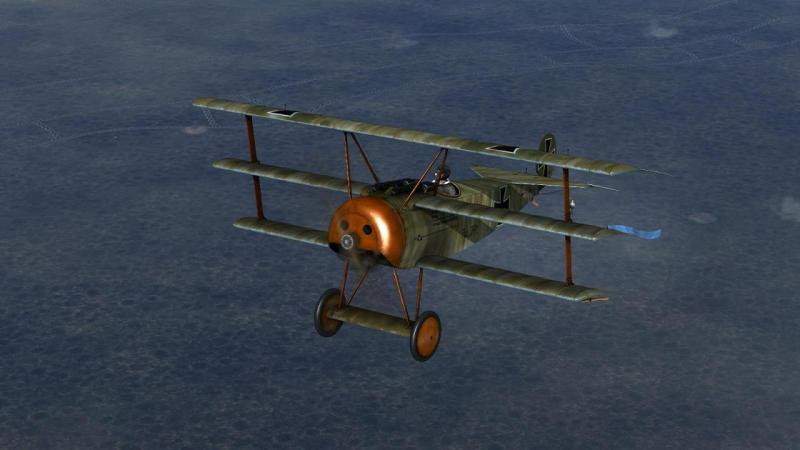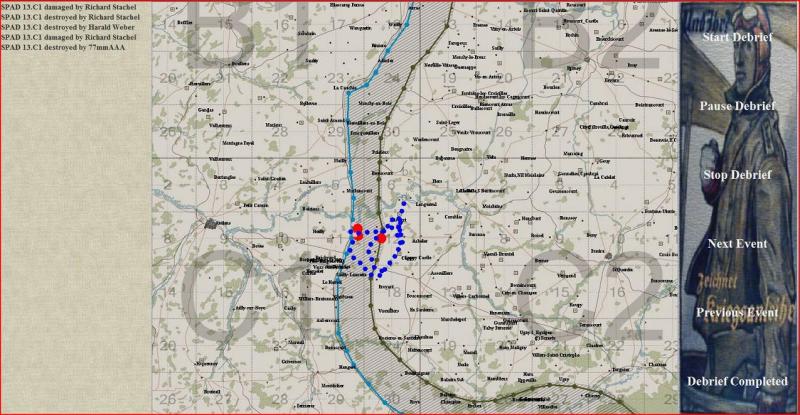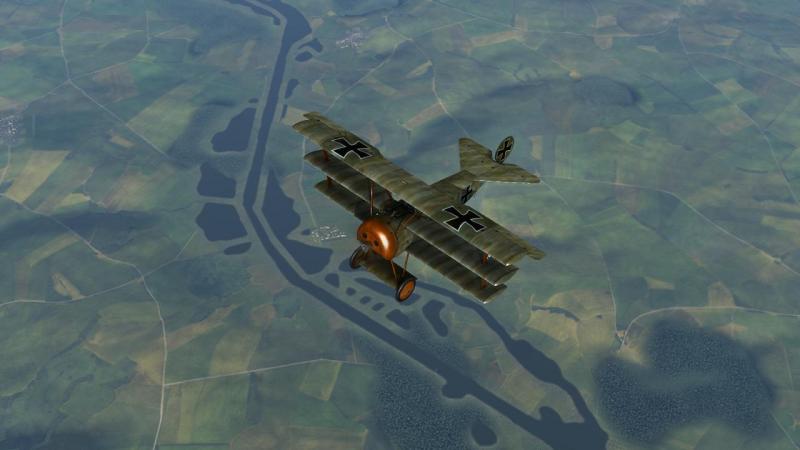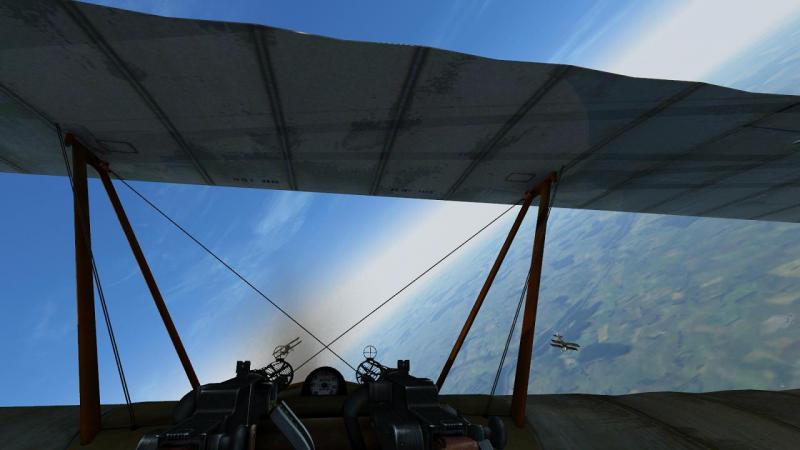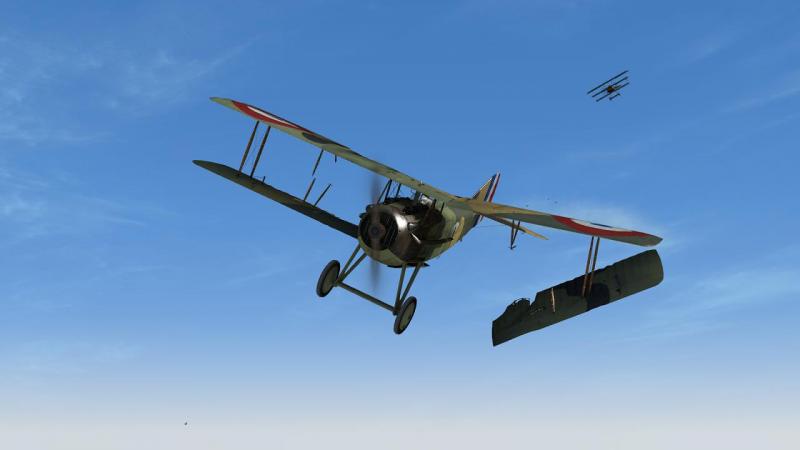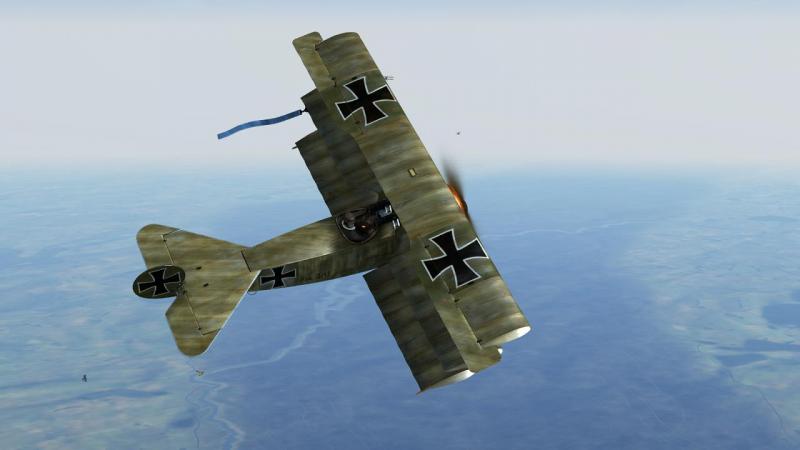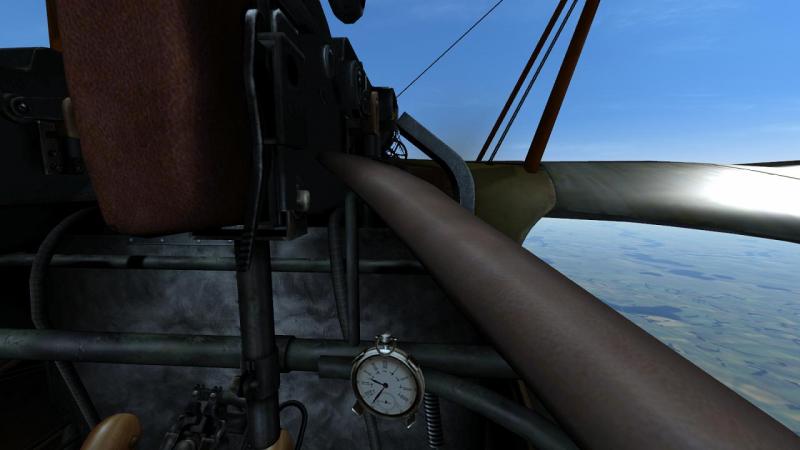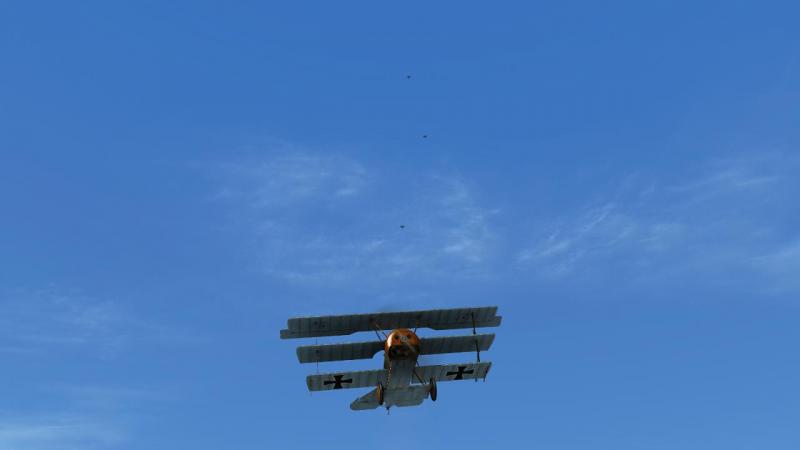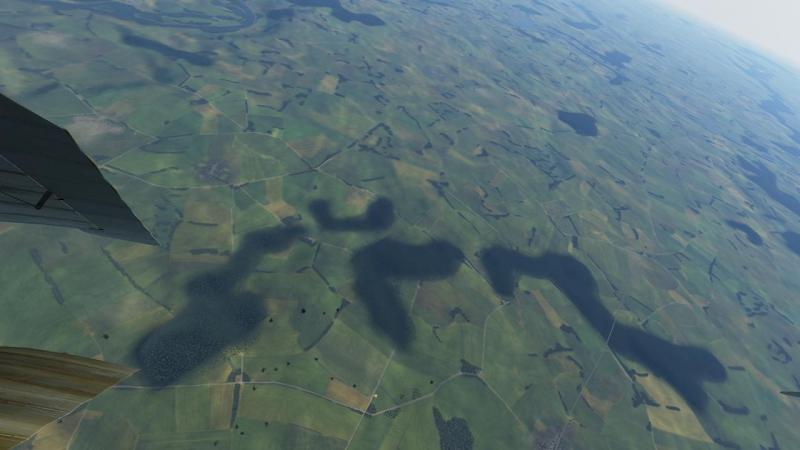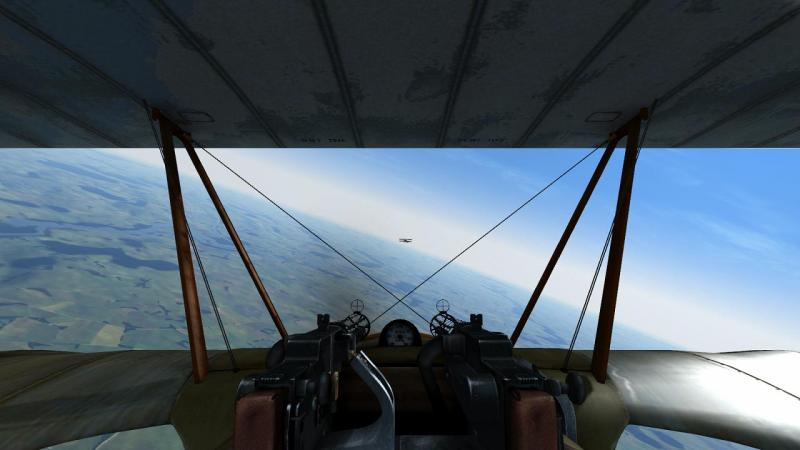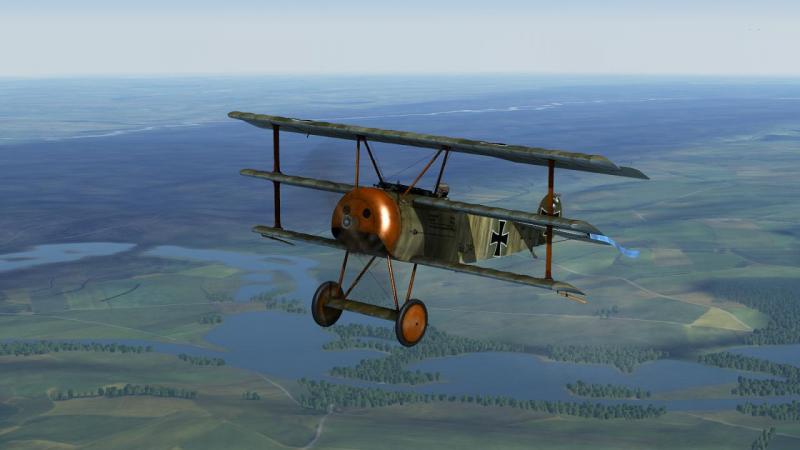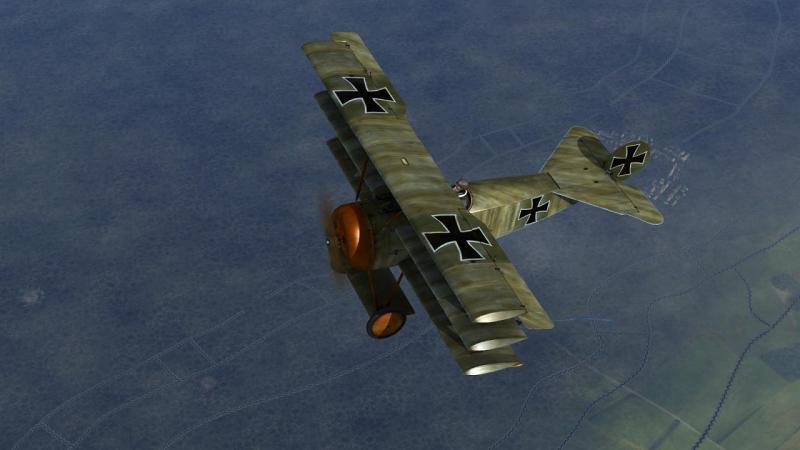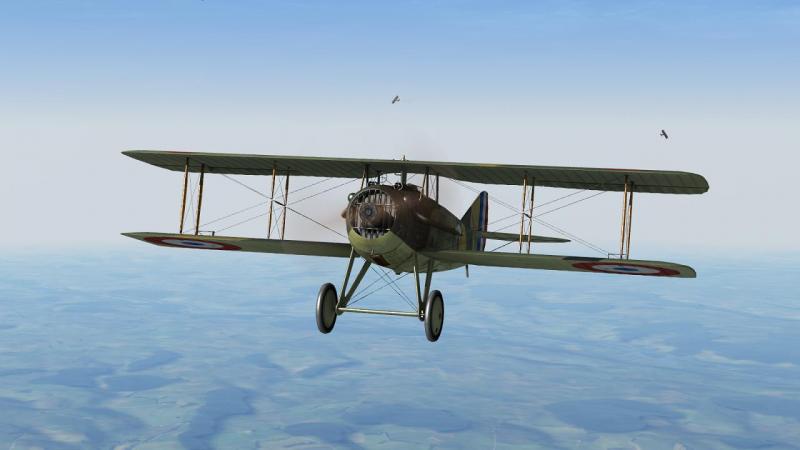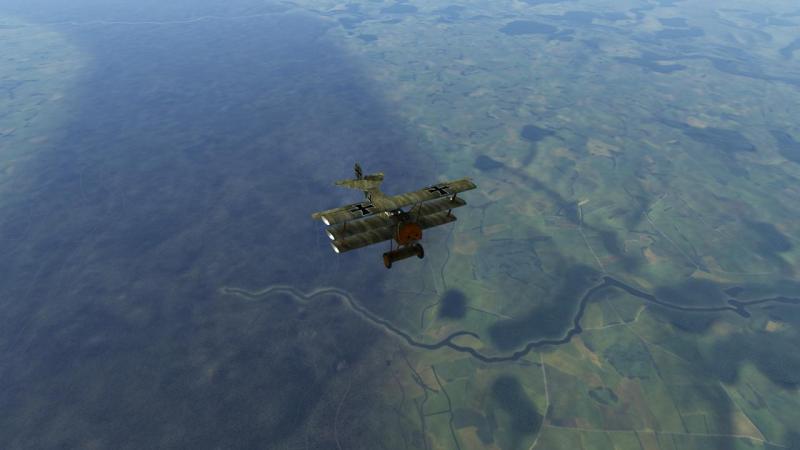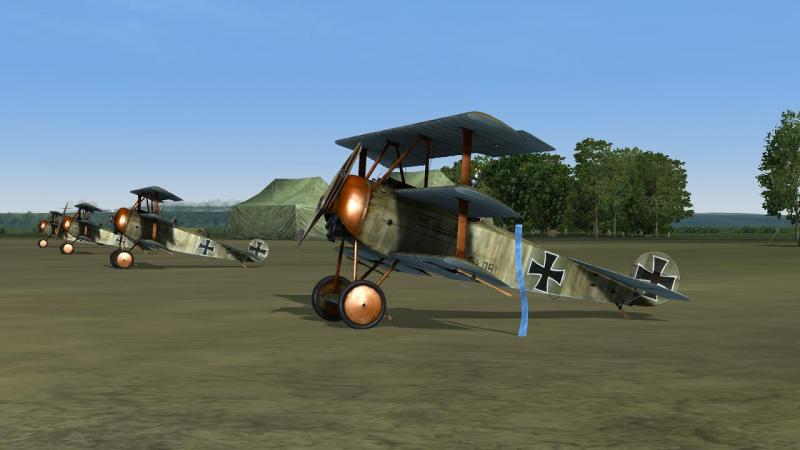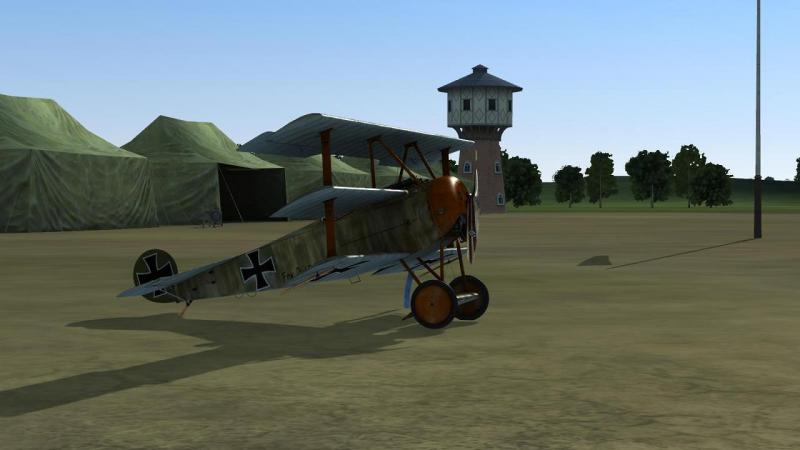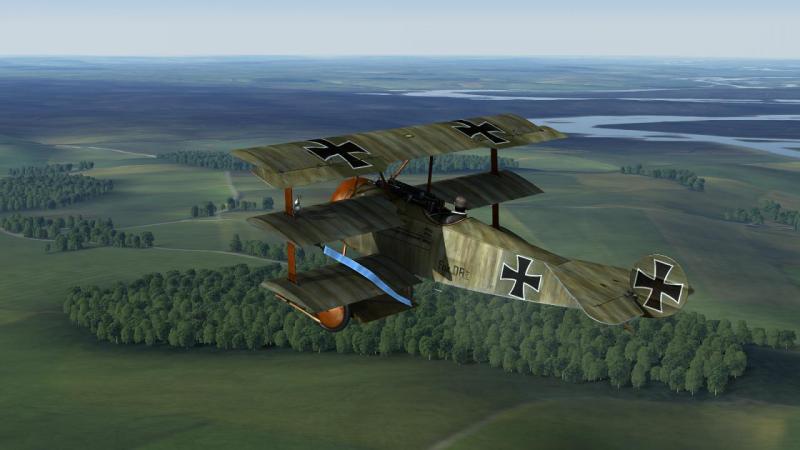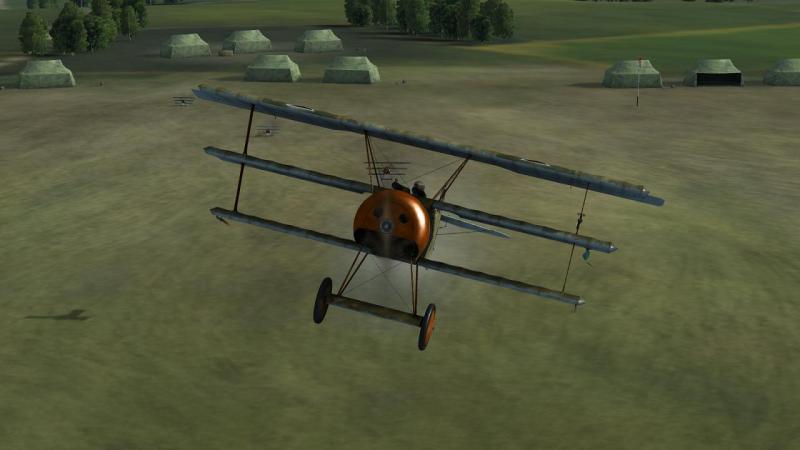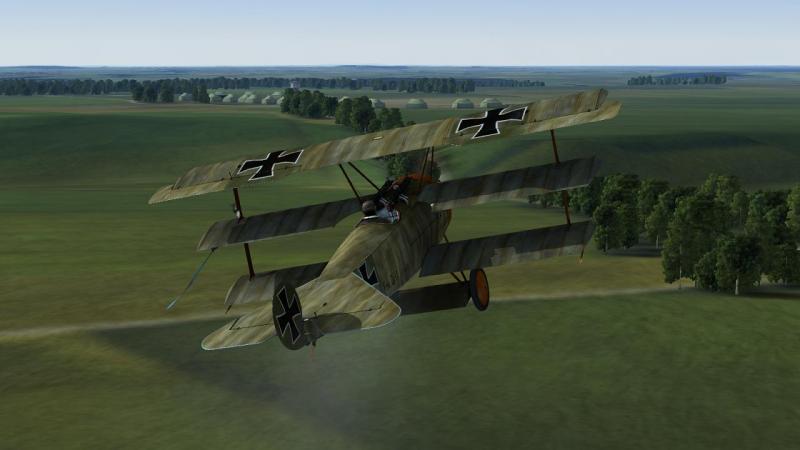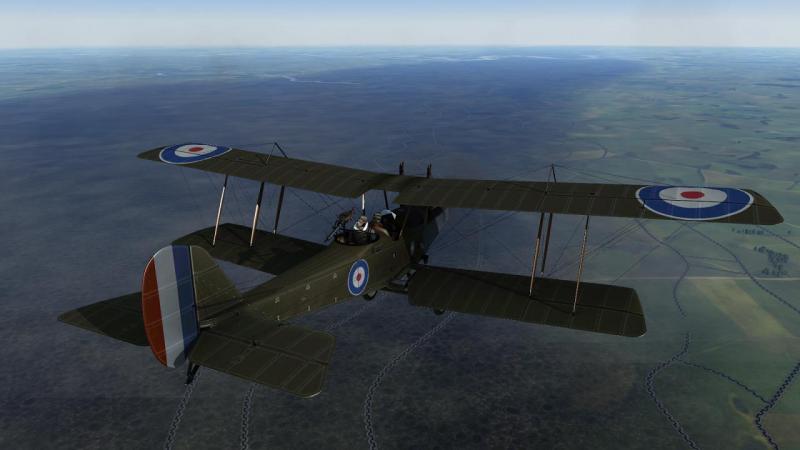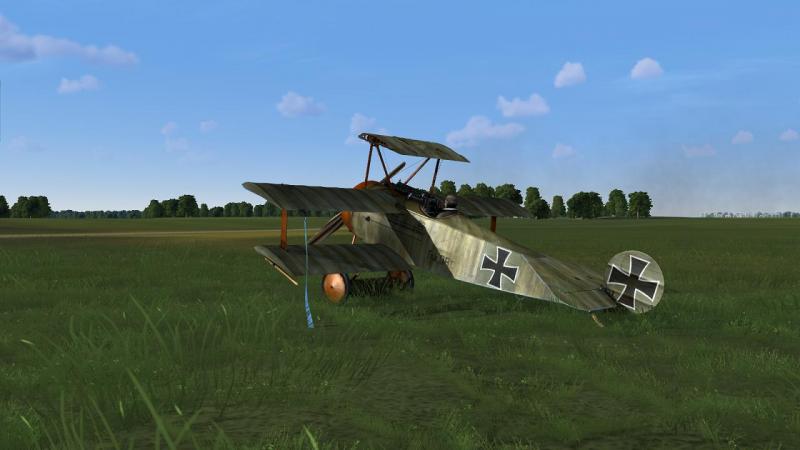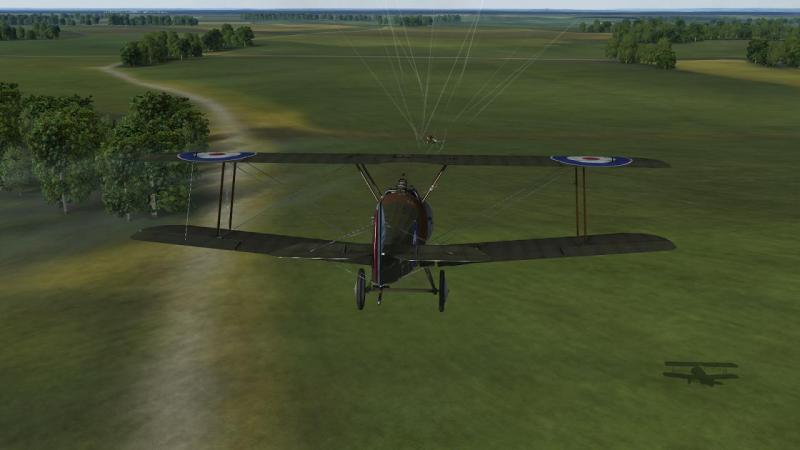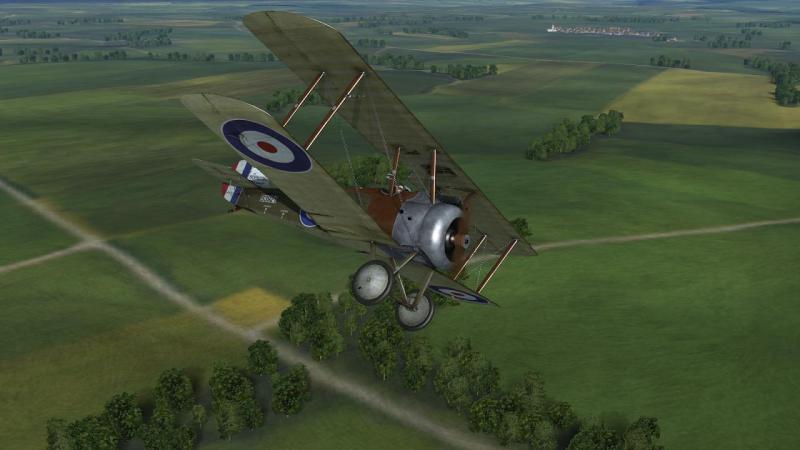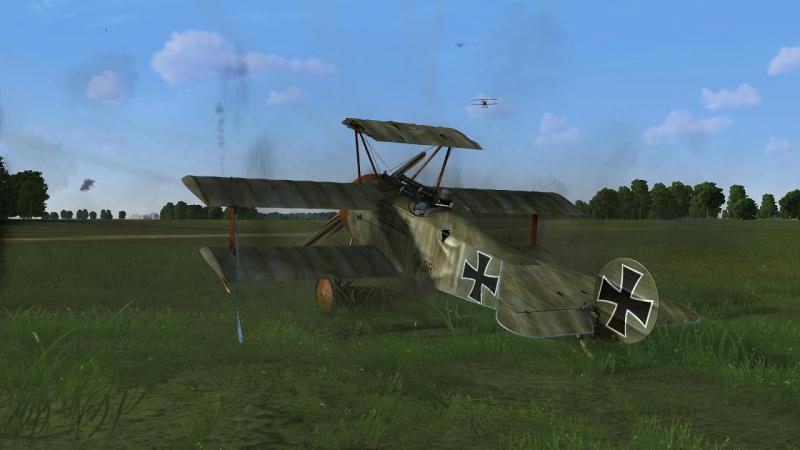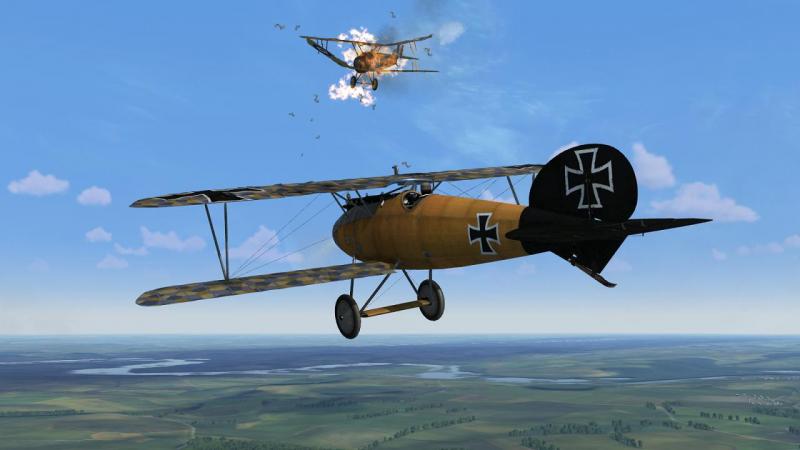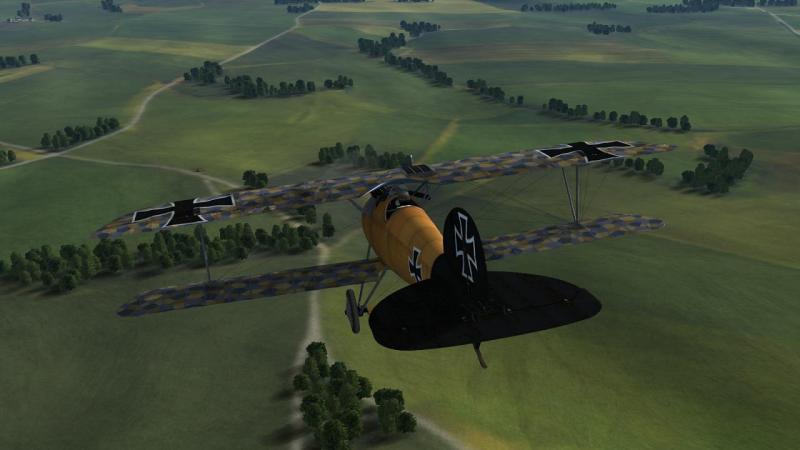-
Posts
3,749 -
Joined
-
Last visited
-
Days Won
7
Content Type
Profiles
Forums
Gallery
Downloads
Store
Everything posted by 33LIMA
-
Footnote - the Enidekker in OFF, and plans for WOFF Having mentioned the limited scope for a Fokker Scouge campaign in OFF, I decided to give one a try. The earliest you can fly the supplied EIII seems to be November 1915, with Jasta 1. This I think is long before that unit's formation, tho the staffel is 'badged' as recce unit FA 32 in its selection screen - the title in the drop-down unit seletion list, and the in-game plane labels, inaccurately show Jasta 1. The OFF Eindekker is, like Laton's FE version, a nice bird, with a rather better-looking cockpit. However, the fact that you can't start a campaign until November 1915 means you've missed most of the 'Fokker Scourge' and will soon yourself become fodder for DH2s and Nieuport 11s. There are some other problems too. OFF tends to allocate rather large flight sizes - for Jastas anyway - and the ten eindekker operation in my first mission seems wildly unrealistic. Even for the later Battle of Verdun 'barrage patrols', I suspect half that would have been a more realistic 'maximum effort'. Still, it was an impressive line-up, most of which you can see in this screenie: The next problem was the unrealistic mission - artillery spotting for a flight of Fokkers! I think Bletchley's campaign mod reduces or eliminates such mission allocations. And anyway, you can just do as I did, and assume that the Herren back at HQ have had a little too much French wine the night before and really intended you to fly a patrol up to the Lines! The next problem I had was finding any enemies. First mission drew a blank. There seemed to be lots of Fokkers in the air - including my unit's first flight of four, which I bumped into, and another Fokker out on his own apparently. But I only found the flight of BE2cs we eventually attacked (on a repeat mission) by turning on the 'radar' (yes I know it's called the Tactical Display aka TAC but if it looks like a radar and it functions like a radar...) AND by increasing its range to the maximum 8 miles. Otherwise, we would have missed them. The grey flak bursts (maybe British fire directed at yet another Fokker behind the BEs?) which trailed them either only started as we got closer or weren't themselves visible further away. WOFF has reportedly tackled the plane visibility issue - not being drawn until about a mile and a half distant is not far enough - by introducing a 'dot mode' you can turn on. There was at least one report that this goes to the other extreme and that the dots can be seen way beyond reasonable visual range. Doubtless this will be tweaked if necessary, the devs having already released some patches. Anyway back in OFF...having closed with the BEs I somehow then damaged my plane diving after them. I had to watch the BE's pull away from me as I chugged along in their wake, with my engine making rather unhealthy chugging noises. The Englishmen were undisturbed also by my flight mates who, having already angered me, as usual, with their poor formation-keeping, seemed reluctant or unable to close with the enemy, despite my increasingly-frustrated 'Attack!' commands. We might as well have gone artillery spotting, for all the good we had done. As for WOFF, OBD has announced a 'Fokker Scourge' add-on, to be released soon, adding to the current EIII two earlier Eindekker versions and a rifle-equiped BE2c (development screenies showed the rifle was a mid-WW2 Lee Enfield No.4!). A possibly more useful addition would be a pilot-only bomb-carrying BE2c, Immelman's first kill being one of these. http://simhq.com/forum/ubbthreads.php/topics/3885222/Addon_Packs_Coming_soon#Post3885222
-
Hi tirta I think the screen with 1.6 maybe just didn't get updated when they made the newer version. In the difficulty settings for IL2, I always turn off engine overheating and don't use 'Complex Engine Management' as I just find it all a distraction; maybe try that, or just tuen off 'engine overheats'. I have similar problems flying the Albatros DIII. For some reason I can't understand, the usual throttle control does not seem to work. Instead, you have to use keys to turn magneto switches on or off to get some throttle control. I can barely take off and cannot keep up with my flight! I think that engines like the Mercedes DIII had a normal throttle control, even if they also had magneto switches. Strange. In one of my SE5 missions, my plane and the others exploded on the ground immediately; I read something about a bug when loaded with bombs that causes this. So there may still be some 'rough edges' to this mod, but it can be a lot of fun and looks good!
- 46 replies
-
- first eagles
- over flanders fields
-
(and 1 more)
Tagged with:
-

F-86 and MiG-15?
33LIMA replied to Gepard's topic in IL-2 Series / Pacific Fighters / Cliffs of Dover: General Discussion
Yes they are in Dark Blue World: Haven't found a Korean campaign for them, maybe because I haven't really looked. Mission4today is a good place to look. -

'In the Nay-vee...' - WW1 seaplane action in First Eagles
33LIMA replied to 33LIMA's topic in Mission Reports
Yes the Schneider is too good a plane not to have in the campaign! It may have been an older model, but the two guys we fought did just fine in it! Next time I will try flying the Schneider myself, and maybe get to bomb some of those ships instead of defending them!- 4 replies
-
- seaplane
- albatros w4
-
(and 1 more)
Tagged with:
-
Hola mi amigo! glad you like the reports, Ojcar. And thanks for the info - I had the old versions, and am downloading the new ones now. Next time against the Nieu. 10 I will not be so lucky! Keep up the modding - looking forward to the next installment!
-
Unfinished business... Some way off, a trail of receding flak-bursts maked the line of retreat of a single aeroplane, which I took to be the second BE2 from the flight we'd been tasked to deal with. To my left, I saw my flight-mate's Fokker turn and head after the retreating enemy. I did likewise. The German flak ceased firing; evidently the Englishman was out of the battery's range. But it wasn't long before another one found him and he was again under fire from the ground, including some tracer fire from machine guns. By now, my flight-mate was steadily closing the range, undeterred by the 'friendly' flak that was bursting around the BE. The Fokker started shooting. Then he stopped, broke off his attack and came around in a wide left-hand curve, back into formation with me. Had he been wounded or damaged? Had he run out of ammo? Whatever it was, this was now up to me. My Fokker seemed to have only a very small margin of speed over the BE and as before, I closed slowly. At first, conscious of the damage I'd taken from his friend in my first attack, I nosed down then pulled up to come at him from well below his tail. But pulling up my Fokker's nose sharply from level flight invited a stall with little time for sighting, so I reverted to making an attack from dead astern and just slightly low. I started cracking off short bursts, in an effort to spook him into weaving, ready at the same time to dodge any return fire. At first he kept to his course, but as I bore down on him he started jinking, then broke into several tightly-banked sustained turns. This made him a difficult target but seemed to give his observer little opportunity to fire. I managed to get off a series of bursts and a final one at short range brought the fight to a sudden close by killing the enemy pilot (who disappears at this point in FE, Strike Fighters-style; as in RoF too I think, after a short interval hunched down in the cockpit). Job done! Six kills in one sortie is a bit extreme, to be sure, even in the fairly busy skies of this first mission. But to put this in context, if I hadn't been very lucky after kill #1, that would have been the end; two of the kills really should have been shared with my flight mate; and two seemed largely attributable to the FE Nieu. 10 apparently having a 'glass fuel tank'. Another point worth making here is that I have not (yet) applied the arc-of-fire mod to Stephen1918's BE2c, so their observers still have a particularly restricted field of fire - even by BE2 standards!. Anyway after the debrief, lucky or not, a nice 'presentation screen' advised me that my achievement was being duly recognised with the award of the Iron Cross, second class. Well on my way, I am, to the coveted Blue Max…if I live long enough! Had I wished to, I could have increased the challenge by upping campaign difficulty from 'Normal' to 'Hard'. From what I've seen, this increases the skill levels of the enemy AI across the board, to the point where the most skilled enemy pilots are really, really scary. But I believe this doesn't change your own flight's skill, so casualties there can be greater, in consequence. As I like to mentor my comrades and see them through my campaigns, I tend to avoid doing this. Another point worth mentioning is that there were several other flights in the air in this mission, doing their own thing. This included some Vickers FB5 'Gunbusses' (one pair was the target of the other flak bursts I had seen), some Morane 'parasols', two Fokker B-types, and a couple more Morane 'bullets', this time from the French air service. I have no idea whether or not I would have encountered other flights if I'd ignored my mission and flown a dozen or more miles north or south. But the FE campaign system can do a great job of putting you in the middle of what looks like an air war going on around you. To me, it feels very like Red Baron 3d and I'm fine if FE doesn't tie up system resources creating and/or tracking events you will (or should) never see. As far as ground activity is concerned, FE campaigns are often quiet but can be as busy or as quiet as the campaign designer chooses to make them and the mission itself requires, featuring everything from guns, trucks, tanks, armoured cars and troops. In FE, I have seen ground battles in progress (as opposed to 'environmental' artillery strikes). But I, for one, am quite happy when it's 'All Quiet ON the Western Front', so long as it's not all quiet, ABOVE it. At least I can routinely see firing AA guns from the air, and even attack and kill them (though I have largely given that up since I started playing campaigns which also feature ground-based AA machine guns!). So there you have it. This was not my first campaign mission in the iconic Fokker in First Eagles and it won't be my last. It was a tense and exciting mission, a flying predator but in hostile skies filled with unforgiving hazards and dangers at every turn. I'd been made to work hard for the results my little team achieved and I had been very lucky to survive that stiff fight with the first Moranes. You can also fly the Eindekker in RoF and in OFF or WOFF. Although I could not resist the delightful RoF Nieuport 11 and DH2, I didn't invest in the Fokker. Superbly-engineered as RoF's Eindekker is, the sim's planeset just doesn't cover the 'Fokker Scourge' period and I had no wish to play the part of fodder for Nieuports, De Havillands or Fees, with no BEs, Voisins or Moranes to hunt in compensation. Hopefully, RoF will one day get a BE2c (and/or a Morane parasol or the like). The position in OFF is only slightly better; there is a BE for your Fokker to attack, but OFF's version of the 'Quirk' is basically defenceless, armed only with a fixed forward-firing Lewis Gun and further handicapped by CFS3-style bomber AI. WOFF, if you have the system to run it, at last remedies this, adding a BE2c with a proper pintle-mounted Lewis, a Morane parasol and a BE12, as well as an Aviatik on the German side - and improving the AI, to boot. However, FE has always had very good AI and it still has much the best planeset for 1915; so it's still a great option to really savour the experience of fighting in or against the rampant Eindekkers. Highly recommended.
-
Not over yet! What I hadn't noticed amidst the excitement was that our fight had drawn the attention of more enemy aircraft, This time, it was a couple of Englishmen in single-seat Nieuport 10s. Looking behind me after the Morane's crash, I could see my my flight-mate was low down near the deck and fighting for his life against some newcomers. I swung around immediately and went for a Nieuport which was chasing my comrade all over the sky. I caught him by surprise and was surprised in my turn when, after a short burst, the RFC machine went on fire and plunged earthwards. Knowing their reputation and my Fokker's limitations, I was rather dreading a fight with these Nieuports. But this pair - flying two-seaters adapted to serve as fighters, not as agile as the later Nieuport 11 'Bébés' - evidently lacked the flying skills of my first victim. To deal with the second enemy, I applied the same tactics I'd used against the last Morane. I let my flight-mate fight him, but took advantage of the enemy's preoccupation to have a crack at him as opportunities presented themselves. Once again, this improvised teamwork paid off and it was not long before another burst from my gun set the last Nieuport on fire, too. I've noticed that some FE planes are more prone than others to become 'flamers' and Stephen1918's Nieu. 10 seems to be in the 'fire risk' category. Anyway, down he went! ...to be continued!
-
Yes I'd say get it. NeverEnough covers it pretty well. Having played OFF and RoF a lot, as well as FEG and FE2, while each does some things best, the latter is IMHO the best current WW1 sim, by a significant margin. WOFF reportedly improves OFF's (have to say it) rather indifferent AI but FE2 already has good AI, plus unbeatable planesets and theatres. FE2's great value - unbeatable, considering the free mods - and doesn't need a highly-specified PC to look great. So even if you're weren't specifically looking for another TW sim, FE2 is a great choice for anyone wishing to experience WW1 in the air.
-
The tables are turned... To digress a little, the warning you get when you're 'pushing the envelope' in First Eagles - a comparatively realistic audible and visible 'buffeting' effect (no 'stall horn', red light or text message!) - is another area where FE really shines. Coupled with good Artificial Intelligence, Damage Models and (at the hardest setting) Flight Models, it's just a great dog-fighting sim. Combine this with sensible wingman commands and responsive wingmen, plus good aircraft visibility and a very serviceable view system, and you get a sim that's also good at patrol-leading. Dog-fighting and patrol-leading - probably the most important things for a WW1 air war sim to do well, and in my experience, FE is best at both. Add to that (including close variants) a couple of hundred flyable planes, unique aircraft and squadron markings, great aircrew animations, several theatres of war, campaigns to match, extra medal packs and skins plus all the other free add-ons, and you've got quite a package, light years ahead of the original rather limited release. Meanwhile, back at the front...the skillfully-flown little French-made monoplanes stubbornly continued to refuse to co-operate in our endeavours to shoot them down. I was now well and truly caught in a close-quarter turning fight, without the height or the speed to 'extend' and then re-engage on my own terms. The urgent need to avoid being shot down myself gave me no time to try to seek help from, or co-operate with, my flight-mate, of whose whereabouts and actions I remained largely ignorant. What to do...??? All I could think of was using the vertical, in an effort to get him into my sights - and keep myself out of his. So I 'yo-yo-ed'. Having been turning hard, my low-powered Fokker didn't have the energy to go up, so that sort of decided it. I pushed my nose down, rolled into his turning circle until my 'lift vector' was ahead of him, and then pulled up. Still no good; he whipped past my nose before I could get off a round. Again! Another try, using what energy I had left. This time, more through luck than judgement, I found myself coming into him from ahead, as he appeared to try to foil my yo-yo by turning into me. Knowing that this fight had been quickly slipping away from me and that I might not get another chance, I squeezed off a short, desperate burst as he zipped past. My clumsily-handled machine shuddered on the verge of another stall and I recovered with difficulty. I looked around, fully expecting to see the Morane on my neck and about to give me the chop. But no! There he was, low down and wings level. Wounded, damaged or just recovering from his last move, I did not know or wait to find out. I quickly swung my sights to bear and cut loose with a long burst which was rewarded with a stream of smoke. The Morane, engine out, glided down to a forced landing. I knew I'd been lucky to get him but I wasn't hanging around to congratulate myself - there was work still to be done! I watched him go for a moment, letting it all sink in, then looked around for my flight-mate. There he was, above and behind me, engaged in a turning battle with the second Morane. I swung around and climbed up to their level. I was keen to see my comrade get a kill but wasn't going to take any chances with these dangerous opponents. So I started making firing passes at the Morane while he was occupied with my comrade - a bit of improvised teamwork. After one frontal pass at low level, I looked back to see the Englishman had rolled over nearly onto his back. I watched as he fell in that attitude into the ground, apparently unable to control his machine. Whatever the damage had been, it had been quickly fatal. I felt a sudden release in tension and looked around again. ...to be continued!
-
Battle is joined! The airfield, its AA defences firing defiantly, remained un-bombed. The BEs sailed on…towards another airfield close by. I only just failed to catch the Englishmen before they finally cut loose with their high explosives. Fortunately, their loads just cratered the centre of the second airfield, leaving the hangars and their precious contents untouched. Now, I was about to make them pay a high price for digging a few holes. I singled out the leading BE and swung in behind him, leaving the second one to my flight-mate. As I was closing the range and lining him up for a burst, the enemy observer opened fire. Tracers whipped towards me and there was the whack of rounds hitting my machine somewhere close by. I nosed down slightly, eased off to one side, and returned fire, snapping out short bursts. The range was a bit longer than I would have liked but I was now committed to my attack. I hoped my fire would cause the BE to evade, enabling me to close the range more quickly. Instead, the RFC machine held its course. Suddenly, he seemed to stop dead in the sky in front of me, as if his speed had suddenly fallen off. As indeed it had; grey smoke billowed back from the Englishman and just before I broke away, out of the observer's field of fire, I could see that his propeller had stopped turning. Trailing smoke but under control, he was still headed for the Lines, but would clearly never reach them. One down, one to go! But it was not going to be so simple... Looking behind to see where the other BE was and what my flight-mate was doing, I got a bit of a shock. There were two aircraft behind me...but both were monoplanes. I stared rather stupidly at this spectacle for a second or two, before I had the sense to break hard right. One of the monoplanes was my flight-mate. But the other was an Englishman in a Morane Sauliner 'Bullet'. There were two of them, in fact, and their intentions were clearly unfriendly. Leaving the BEs for now, my comrade quickly went for one of the Moranes. I seemed to be Number One on the other Morane's hit list and had to break hard to avoid his tracers. My friend seemed well-placed to deal with his chosen target; the other Morane was clearly going to be down to me. As I turned into the RFC machine, it didn't take me long to realise that this was not going to be easy. I've been flying FE quite a while now and one of the good things about the AI is its variability. And the fact that you can quite quickly form an opinion about the skill of the individual enemy you are facing, from how he flies. This guy seemed to be at the 'hot shot' end of the scale, from the way his machine zipped about the sky and refused to be shot down. My Fokker soon showed itself for the rather primitive fighter it was. Tight turns had often to be backed off as my machine shuddered on the verge of a stall. To make matters worse, the other Morane had avoided my flight-mate's attack and it was now everyone for himself with the well-flown Moranes looking likely to come out on top. ...to be continued!
-
The 'Tizzy angle', World War One-style Unsurprisingly, my 80hp Fokker was neither particularly fast not a great climber, so overhauling the enemy flight was a slow job. I kept my climb rate low to maintain airspeed, anxious to intercept them before they reached the nearby airfield, lest they be intending to bomb it. As we gained height, I adjusted my heading to acquire and maintain the 'Tizzy angle'. This is nick-named after the Polish WW2 RAF pilot who described how the optimum intercept course involved keeping your heading such that the enemy plane stayed at the same angle in your arc of vision, as you closed. If it seemed to be moving ahead, you were liable to come in behind it and end up in a tail chase. If it seemed to be slipping backwards, you were going to arrive ahead of it. Keep the enemy's image fixed in a constant direction, just growing in size as you closed, and you had it right - the 'Tizzy angle'. I closed slowly but steadily, watching the flak banging away. Looking around in case of threats, I could see another trail of bursts in the sky, some way off to my right. They didn't seem to be heading my way. My assigned target was in sight ahead, so I stuck with that. As any good Prussian officer will tell you, orders are orders. The race was now on - to intercept the enemy airmen before they arrived over the friendly airfield! As we came closer, I could see that my wish was about to be granted. Having flown Stephen1918's superb new BE2c, I now wished to meet it in the air, in combat, and that is exactly what these two enemy machines were. BE's often left their observers behind to carry more bombs but the emergence of the threat from Fokkers rather inhibited that practice. These two, though bombed up, were also ready to defend themselves. It finally became clear that I was not going to reach the Englishmen before they reached the airfield. I saw the BEs change course as they swept over it and cut the corner to catch them, glancing down to see the impact of the bombs I had not been able to stop. ...to be continued!
-
Recreating the dawn of the fighter aircraft in First Eagles 2 "Hundreds, nay thousands of machines have been ordered which have been referred to by our pilots as "Fokker Fodder" ... I would suggest that quite a number of our gallant officers in the Royal Flying Corps have been rather murdered than killed" Noel Pemberton-Billing MP, campaigning in 1916 against the dominance of the Royal Aircraft Factory in the design of RFC aircraft "...McCudden gave him another burst, and the Fokker broke off the attack. For the rest of the flight, the Fokker merely accompanied them, more like an escort than anything else. 'We live and we learn' was McCudden's comment on the deflation of the Fokker Menace story" Alexander McKee in 'The Friendless Sky' The deployment of small numbers of a rather inferior monoplane armed with a fixed machine gun synchronised to fire forward through the airscrew was just one of a series of swings in the fortunes of the main combatants in the WW1 air war. Shortly beforehand, French pilots like Garros and Pégoud had sent shock-waves through German ranks with similar weapons, unsynchronised but with deflector wedges to protect their props. And within months, the Fokkers themselves had been eclipsed by superior enemies in the form of the Nieuport 11 and DH2, which in turn were outclassed by the Albatros. But it's the Fokker 'Eindekker' which gave its name to a whole chapter in air warfare, even if this owes as much to its exploitation in a British politician's campaign to secure a bigger role for private enterprise in British military aircraft design, as it does to the plane's own qualities. For despite its gun, the Fokker was a rather mediocre aeroplane, low-powered, with wing-warping rather than ailerons. And while its principal RFC prey the BE2c certainly suffered from a badly-placed observer with a limited field of fire, there are accounts which confirm the BE was not just the 'Fokker fodder' of legend and could defend itself ably enough if well-handled and not caught by surprise. Anyway, enough potted history! Having recently flown Stephen1918's superb new BE2c in the hostile skies of Spring 1917, I wanted to step back nearly two years and see the BE (and/or its fellow RFC machines) from a different perspective - through the gunsight of a predatory Fokker pilot, hunting his two-seater quarry in the period which truly pioneered the concept of the fighter aircraft. I decided to kick off a campaign in Ojcar's 'Armchair Aces' month-by-month campaign, starting in August 1915. At this time, Immleman and Boelcke were on the threshold of making names for themselves flying their new Eindekkers. Keen to do likewise, I created a new pilot and opted to fly with Kampfeinsitzer Kommando (KEK) Douai, based at nearby La Brayelle and flying against the RFC. Thanks to the modders, no other modern WW1 sim comes close to First Eagles in its flyable planeset, just as Red Baron 3d set that standard, before it. FE benefits from an excellent series of Eindekkers by modders Laton and BortdaFarm. Versions available are the EI, EII, EIII (which look much the same but have progressively more powerful engines) and even the twin-gunned but overweight EIV. And there are some look-alike Pfalz equivalents. For this campaign, our mount was the Fokker EI, with only an 80hp engine and a single 'Spandau' 7.92mm LMG 08/15. Ojcar's 'Armchair Aces' campaign integrates modder aircraft like these (and many more) into the FE campaign system and was therefore a natural choice to try my hand with an Eindekker in campaign mode. At this time, it was common for a flying unit on any side to operate more than one type of aircraft. Fokker monoplanes were initially allocated in ones and twos to ordinary two-seater units. While I believe you can do this sort of thing in single missions in FE, in campaign mode you have one plane type per squadron. As a staffel's Fokkers seem generally to have operated independently of the unit's two-seaters, it's easy enough to handle this by using the squadron roster, pre-mission, to ensure you fly either on your own or with one or maybe two companions. No need for missions with eight or twelve Fokkers lined up on the flight line, impressive though that may look! Operations in (slightly) greater strength become more realistic later, by which time Fokkers were often concentrated into Kampfeinsitzer Kommandos. I believe KEK Douai was associated with two-seater unit Flieger Abteilung 62 and actually formed in late 1915. Our first mission was in effect a 'scramble', to intercept an incoming enemy flight headed for Aniche airfield nearby. Although air defence/air raid warning systems were rudimentary at this time, it is clear from many accounts that Eindekkers were 'scrambled' in this fashion and did not always just fly patrols. To accompany me, I'd selected one other pilot, a senior NCO by the name of Rall, and here we are on the grass at La Brayelle. Assuming you haven't opted for an air start, FE starts you off in this fashion, with your prop just starting to turn, which gets around the issue of invisible ground crew in other sims (although I quite liked the invisible mechanic's cry of 'Good hunting, sir!' or 'Hals und beinbruch!' as you started up in CFS2 WW1 expansion 'Combat Aces'). As we took off, I noticed flak bursts quite low in the sky, ahead of us. Snatching a glance at the in-flight map, it seemed clear that this must be the flight we were intended to intercept. Peering into the sky near the tip of the trail of busts, I could make out a pair of specks. These looked to be heading towards a friendly airfield which I could see as I gained height, a few miles distant. Today, I would not have to look far; trouble was coming to me! ...to be continued!
-
Brilliant! Not worried about moving trains - but railways played such a major role in WW1 that their omission from FE's landscapes has always been the big gap there. In particular, stations and goods yards were always such a major bombing target. It would be a great step forward, visually and operationally, to have railways and station targets added to terrains and campaigns. Railway lines and bridges, stations and goods yards with rolling stock you can attack or defend...drool!
-

'In the Nay-vee...' - WW1 seaplane action in First Eagles
33LIMA replied to 33LIMA's topic in Mission Reports
Come on in, the water's lovely! At this point, flushed with success, I blundered across the nose of my flight-mate, who was being hotly pursued through the flak-bursts by the other Englishman, in the second Sopwith Schneider - for that is what these aircraft were: floatplane derivatives of the the same company's pioneer little Tabloid landplane. A little out of place in the skies of late 1917, perhaps, but these two were flying like that thought had never occurred to them. My comrade broke away and down, with the Spowith behind him every step of the way, undeterred by the pool of oil on the sea which marked the grave of his friend. I banked around, then dived in for a quick pass, before pulling back up to re-assess. Re-assessing the situation didn't take long. Though I had got him off my flight-mates neck, the Sopwith was still very much in action. Next thing, the two were back up at my level, snapping at each other's heels. Knowing better by now than to get into a turning fight with these nimble little Britischers, I 'extended' then came back in for another pass. Once, twice, a third time. The Sopwith banked and dived out of my way each time, on the last occasion pulling up just as I thought he was sure to pile into the sea. On my fourth pass - by which time, I was beginning to get worried that he might nail my flight-mate in between my attacks, if we let this go on much longer - he turned into me. All right, head on it will be, then, I thought to myself. My two guns against his one. I lined him up and held down the trigger. At the last moment, he seemed to veer slightly sideways. I was determined to get him this time and I kept my nose onto him, taking advantage for that fraction of a second of being out of his line of fire and having a slightly-bigger target for my own guns. There was a bang and my machine lurched, then started to roll to the left. A collision! By crossing my controls I managed to stop my kite rolling over and throttled back as I steered desperately for the sea, minus a large section of my port mainplanes. As I came in, I could see that my nose was yawed well off my direction of travel, as in those crazy crosswind landing clips you see. I planed to kick her straight with the rudder just before touch-down but I over-did it and lost the deflection I had needed to keep the wings level. Too late to correct, my machine rolled hard left at the moment of landing...bang! All over! To cap it all, the Sopwith whom I'd bashed into - though damaged enough to quit the fight and head for home - had obviously come off best. As he flew off, there was first one and then a second violent spash, as two other aircraft hit the sea, not far apart. The Sopwith Babies had arrived, and as I found out later from the debrief, my flight-mate, not to be out-done by his leader, had collided with one of them. Evenyone else just went about their business, including the two Rumplers, another pair of Schneiders, and a bloke in a two-gunned Hanriot floatplane, who would likely have been a much more dangerous foe than any of the Sopwiths. You never know with FE, though; the variable AI means you can come up against a variety of skill levels in the opposition you meet. This was my first mission in an FE seaplane campaign and I must say I thoroughly enjoyed it. The 'air-to-air' was typically First Eagles, close up and personal, a dogfighter's dream (or nightmare, depending on result). As an areo-naval sim, FE evidently has its limitations. The seaplane tenders and their consorts may be potential targets but are I think static, placed like airfield buildings in a conventional landscape. There is no land in the North Sea 'terrain', nor any landplanes in the campaign. And the planes there are, are a bit of a mix as regards era; and no two-seaters or flying boats (yet, anyway!). But they are really lovely to look at and excellent foes or mounts, as you like it. Ojcar's campaign with Stephen1918's planes, ships and terrain are an excellent way to experience a dimension that so far only RoF amongst current WW1 sims can manage. Highly recommended!- 4 replies
-
- seaplane
- albatros w4
-
(and 1 more)
Tagged with:
-

'In the Nay-vee...' - WW1 seaplane action in First Eagles
33LIMA replied to 33LIMA's topic in Mission Reports
'This is not a drill...' As it happened, we were far from the only enterprising naval fliers in the air that day. Some of our friends were airborne, including a pair in Rumpler 6B1s - a single-seat fighter adaption of the same company's C-type machine which pre-dated the more successful Albatros I was flying: There was also this rather less friendly pair. Although they were headed in the direction of us and our ships, these Sopwith Babies were not the target for all the anti-aircraft fire which our vessels had unleashed. My wingman seemed to see them before I did. Looking up and quarter left, I could see the flak bursting in the sky, tracking steadily and menacingly straight at us. As the range wound down, the two specks at the head of the trail of flak bursts resolved themselves into the form of two floatplanes in echelon formation. I nosed up towards them, knowing that they were high enough to fly right past us if they were on a bombing run. No way was I going to be able to save our ships from being bombed, if that was what these two had in mind. Fortunately, perhaps, it was us they were after - me and my flight-mate, not the ships. They accepted my challenge and dived straight for me, guns soon blazing. For the avoidance of doubt, I gave my flight-mate a hasty command to attack. In no time, the four of us were whirling round and round in a merry little dogfight. It did not take me long to realise that these enemy pilots were either very skillful or they had machines which were rather more nimble than mine. My flight-mate went for one of the Sopwiths, but as you can see from the pic above, the second enemy machine whipped around and was on his tail in an instant. Here's my chance, I thought, to save my comrade and get an easy kill. The first bit went as planned; the second did not. I managed to shoot the Sopwith off the other Albatros's tail but I then found myself in a turning fight with an agile foe I could only manage to hold in my sights for the briefest of intervals. I got quite close at times, despite the flak bursting merrily all around me. I knew I was hitting him, but he seemed somewhat reluctant to go down. After a final burst at close range, he started trailing smoke and I saw his propeller grind to a stop. He sideslipped away, down and out at last. One down, one to go! ...to be continued!- 4 replies
-
- 1
-

-
- seaplane
- albatros w4
-
(and 1 more)
Tagged with:
-
Life and virtual death on and above the ocean waves in Ojcar's 'Unsung Heroes' seaplane campaign Rise of Flight is not the only WW1 flightsim to feature seaplanes. Thanks to modder Stephen1918, First Eagles/FE2 also got its feet wet, with a series of floatplanes suitable for the Channel coast and a 'terrain' package, complete with some shipping. Fellow-modder Ojcar then provided us with a campaign to complete the scene. The aircraft are available here... http://combatace.com/files/category/360-first-eagles-add-on-aircraft/ ...the terrain is here... http://combatace.com/files/file/14129-north-sea-terrain/ ...and the campaign is here: http://combatace.com/files/file/14164-unsung-heroes/ The campaign needs a separate install of FE, which for FE2 is just a matter of copying the game executable, renaming and running it. This creates the 'mods' folder where you install the new items. The drill for FE(1) is slightly different but equally simple. You can combine the seaplanes in a normal install, but this campaign really needs a separate one, to avoid oddities like vehicles or landplanes moving on the sea surface. This limits the campaign to aero-naval action but it's nicely done and makes a fun and interesting challenge, nevertheless. The campaign is set in 1917 and the briefing sets the scene nicely, with some short but interesting historical background to help you get 'in character'. The Germans, having occupied a stretch of coastline running from the eastern end of the English Channel to the southern end of the North Sea, are contesting the British and allied blockade and running some naval operations of their own. Both sides have the support - for this campaign - of seaplane tenders and their aircraft. Which is where the player comes in, of course. I elected to fly for the German side, in a late-model Albatros W4. This was a fighter, basically a scaled-up Albatros DII with two large floats. For our first mssion, dated 1 November 1917, two of us were detailed to fly a defensive partol around our tender, the SMS Answald. I could have increased our strength by selecting more pilots from the squadron roster, but I thought we'd stick to a twosome. That was my first mistake. Anyway here we are, ready for the 'off'. If you don't have an air start selected, FE, logically enough, starts you on the ground. Also logically enough, if there's no ground - as in, the middle of the North Sea - you're started on the water. Like so. The ship in the background isn't our tender - which vessels were the progenitors of proper aircraft carriers - it's our surface escort. WW1 warship identification's not my speciality and it may be a representative type rather than a model of a real vessel but it looks suitably Victorian. I suspect FE doesn't model sea states which is just as well as I had enough trouble with all that water, in the 'dead calm' we got. Getting off the ground - sorry, water - was the first challenge. Basically I opened her up and when it felt right, pulled back on the stick to increase the angle of attack and get a bit more lift in an effort to unstick. This worked...eventually. But my W4, once airborne, soon confirmed my suspicion that she was going to be rather less tractable than the scouts I was used to flying. She felt somewhere in between one of those, and a two-seater. Slow in the climb, ready to buffet in an impending stall if I increased the AoA too much, but reasonably willing to turn without behaving badly. As you can see, you don't get a wake effect (unless I've not installed something somewhere, must check...) but the sea surface and our little flotilla made a nice backdrop for Stephen1918's beautiful plane, as myself and my wingman - the AI manage water takeoffs just fine - climbed slowly away. In a nice touch, our ships fly the correct Imperial German ensigns at stem and stern (the former being the pointy end, I believe). Behind us in the pic below, you can see both our escort and our seaplane tender. As I orbited, slowly gaining height and getting a feel for my machine, the gunners on both our ships decided to give me a little surprise by commencing some brisk shooting. Fire and smoke bellowed from every barrel and tracer fire sped up and past us, directed at a target or targets which I had not yet seen. Obviously, our patrol was going to be no mere sight-seeing trip... ...to be continued!
- 4 replies
-
- seaplane
- albatros w4
-
(and 1 more)
Tagged with:
-
Oh, that looks good!
-
Down...but not out! Having shot away the SPAD's interplane struts on one side - and some of his bracing wires on the other - I pulled aside and waited for his wings to fall off. No sense in using up what little ammo I had left, eh? Down below, the German flak gunners didn't seem to share my confidence in the SPAD's imminent and inevitable demise. They seemed to have briefly paused in their shooting while I had made my own attack. But as the SPAD, slowly losing height but still flying, edged back towards the French lines, the flak resumed firing at him. The gunners were right. The SPAD just kept on flying, impossibly but surely. Cursing the vagaries of the impressive but sometimes wayward RoF damage model, I closed in from the SPAD's left rear, trying to keep clear of the flak bursting in his wake, and opened fire again. By this time, what with previous stoppages, only one of my Spandaus still had some ammunition left. Gun firing all right, gun stops. Carry out the Immediate Action - cock the weapon and carry on. Gun still not firing...out of rounds! At that point, something extraordinary happened. An AA round burst right in front of the Frenchman. The SPAD seemed to flip upright, vertically, with his wings suddenly at right angles to the airflow. The violence of this move ought to have torn his wings clean off, damaged or not. But it did not. Instead, the SPAD nosed over onto one side and then fell away, as I watched, rather dumb-struck by these odd proceedings. The German flak seemed to be equally bemused and stopped firing. The bullet-, shell-, and aerodynamics-proof Frenchman leveled out and continued to edge diagonally across towards his front lines. I went down after him and closed in, indulging in a spot of formation-flying with my erstwhile foe. I seriously contemplated edging right over, slipping my wingtip under his, and trying to flip him over into a fatal dive, as Spitfires are known to have done with V-1s in 1944. But I thought better of it; I was not going to risk my virtual skin thus. The SPAD kept on keeping on, descending very slowly. I let him drift off to my right, and finally saw him make a respectable forced landing close to the foremost enemy trenches, seemingly untroubled by nearby shell-bursts from German field artillery, who had evidently decided not to waste their own rounds on this indestructible enemy aeroplane. At that point, I called it quits and headed home. To be honest, in the excitement I had forgotten about my flight-mates; I could have tried to order them to attack that last SPAD but instead, settled for leading them home alive. This was some consolation for the SPAD's refusal to do the decent thing and fall to pieces. Best of all, when I ended the mission in RoF and switched back to PWCG, I discovered Weber's kill, which made it two-nil for the mission; three if you count the force-landed SPAD. The debrief screen is below. I believe I could have zoomed it in to get a clearer view, but you can still see how it shows my track, RB3d-style, in blue dots, and top left lists the highlights of the mission...crediting the third SPAD to the AA gunners in fact! I suppose this was fair enough; they showed me where he was and enabled me to set him up, for them to knock him down, in the end. This superior mission debrief is another of the great features of PWCG. Anyway, the main thing is, I now see respectable levels of flak, with PWCG-generated campaign missions. I will try increasing air and ground object densities, to see if it can be increased further, without overstraining my modest system. More AA fire (and brighter, slightly more persistent flashes from each burst and more visible smoke 'puffs') would be nice, although I gather than there are some limits in RoF which bite here, and that PWCG flak is thus limited to parts of the Lines and some potential rear-area targets, and may thus never be quite as common (and useful a target indicator) as it is in FE2 or OFF. Still, it's a major improvement - to realism, as well as playability - and I'm much looking forward to further outings with PWCG, whose continued improvement seems remorseless! Great stuff - PWCG is highly recommended (as is RoF and its magnificent Fokker triplane)!
- 9 replies
-
- rise of flight
- rof
-
(and 1 more)
Tagged with:
-
Let battle begin! Reaching the northern limit of our assigned patrol route over the enemy trenchlines - and ignoring both the inaccurate flak and the SPADs the view system had revealed were lurking under our tails - I swung us around and back to the south. The SPADs followed, gradually gaining height and creeping closer. At this point, looking around as I completed my turn, I legitimately spotted one of the SPADs, swinging around below and behind us, now just a couple of hundred feet below. I banked around and spiraled down onto the enemy scouts, giving my flight the signal to attack, as I did so. The battle was on! My sudden appearance amongst them seemed to startle the French fliers and I was soon making good shooting at one of them. The other SPADs fought back, making plenty of use of the vertical. Their speed made them hard to catch. I refused to dive down after them but watched and waited for one to reappear at my level, before attacking. They kept up their speed and I was reduced to some long-range snap-shooting, firing carefully-aimed short bursts in an effort to force them to turn without wasting my ammunition. At this delicate point in the combat, my view system went haywire. I was mouse-looking around and tried to padlock a target. Instead, it was as if my virtual pilot had collapsed in a heap with his head down towards the front right of the cockpit. This, perhaps, is not the viewpoint most conducive to effective dogfighting, I thought to myself. Unable to move my cockpit viewpoint, I switched to the external view and disengaged, flying east towards friendly territory while I continued to struggle to restore my ability to see more than the breech ends of my machine guns, my pocket watch and a nice patch of blue sky. Looking up, I could see my three flight mates. Like me, they seemed to have the sense not to fritter away their height advantage. Evidently, the remaining SPADs had disengaged too, at least for the time being. I did not know at the time that one of my flight - Weber - had also destroyed a SPAD, and that the other had dived down and out of the fight. I'm not sure how I managed it, but as I came level with the German reserve trenches, I managed to clear my stuck cockpit view. And this was the point when, at long last, AA fire stepped in, to provide a clear indication of the presence of other aircraft. There, below me, was a trail of black flak bursts. And at its head, was another aircraft - a SPAD! I rolled over and went for him like the proverbial bat out of Hell. He seemed slow in seeing me coming and I got into position behind him, snapping out steady bursts as the range wound down. I knew I was low on ammo but my fire soon took effect. ...to be continued!
- 9 replies
-
- rise of flight
- rof
-
(and 1 more)
Tagged with:
-
Waiting for Godot Archie... As we gained height on our leg to the south, running parallel to the Lines, I could see that my flight-mates were lagging a little. So I throttled back to enable them to catch up. Thereafter, they maintained formation quite well, despite some porpoising on my part - nearly as good the AI does in FE2 and much better than in OFF (don't know if WOFF improves this) where your flight slides well outside, even in gentle course changes. Also in RoF, your wingman command set lets you vary formation, though I'm not sure if this was so practicable in real life. I stuck with the default 'echelon right'. Despite the tiring tail-heaviness, the experience of flying in RoF is IMHO much the best in any current WW1 sim; not to be missed. The visuals are just great. Here's the DrI's cockpit, which is complemented by dynamic shadows (FE/FE2 has these but not OFF/WOFF) and the superb sounds: I also love the RoF terrain and environmental effects. Even on my lowly graphics card, they look fantastic. OFF/WOFF's more varied trenchlines (also those of IL-2 DBW 1916) are better and RoF's overall effect is perhaps a tad bland or impressionistic but I find it extremely convincing and effective. Some of the scenery 'items' like towns look a bit like models placed in a wargame landscape rather than a model diorama but I still think RoF's the best, though I have yet to fly over WOFF's impressive new landscapes. By now, as we neared the Lines, I had my eyes peeled for signs of air activity...especially for any flak. I switched to the external view and had a good look around. Cheating? Not to my mind, not at all; just some compensation for the limitations of 'MonitorVision', in effect flying with your head inside a box with a rectangular flap cut in the front. That's not realistic either, no matter which method you use to 'move the box around'. Anyhow, of flak or enemies, nothing did I see...not yet anyway. Early days, still. As this mission was something of a try-out for flak activity levels, I decided to use the excellent RoF view system to really cheat and see what else what was in the air, even though I was not going to react to anything thus revealed, until I spotted it 'legitimately' (I fly RoF with no other aircraft icons on the in-flight map screen). And this is what I saw: There were three French SPAD XIIIs in the air. The two behind looked in the pic above like they were recovering from a near-miss while attempting to keep formation (which I have seen happen before, in OFF and FE2 as well as in RoF). Looking around to orient myself, I realised the SPADs were behind and below us. In fact the b***ers appeared to be stalking us, as we turned and flew north, approximately along the line of the enemy trenches. At that point, Archie put in an appearance! I'm fairly sure he was firing at us, not the Frenchmen. I heard the rounds before I saw them, for they were bursting consistently well below us, and did not do a very good job of correcting their aim. AA bursts are not as visible in RoF as I'd like them to be. You can see them clearly in the 'SPAD's eye view' below (my flight is the top line of specks) but in the view looking down and behind from my own machine, the bursts are lost against the terrain, and even the flash of their bursting is not much better. But at least, the AA gunners were now in business and earning their crust. ...to be continued!
- 9 replies
-
- rise of flight
- rof
-
(and 1 more)
Tagged with:
-
Archie arrives at the front (the RFC knew AA fire as 'Archie' after one of its pioneer fliers, unimpressed by the accuracy of early German AA fire, famously began singing the ribald music hall ballad 'Archibald, certainly not!' as the rounds burst) I generated my second Jasta 11 mission and found the date had advanced to 3rd April 1918 and our unit had been re-located to Cappy. I have 'moving front' disabled in PWCG so the front lines are where they appear in-game, which I think (correct me if I'm wrong) is fixed in RoF and thus does not reflect the gains made in the German spring offensive. Anyhow, our airfield was conveniently close to the trenchlines and we were assigned a patrol mission, which I accepted, again having ensured that I led the flight and that we were four in number. Here's the PWCG briefing screen: You can see the large town of Amiens on the left centre of the map and Cambrai, top right. The red and yellow dots appeared after I had accepted the mission, if I recall right; likewise the linked dots of green-brown and light blue. The latter may signify each side's active front - very useful if they track the 'moving front' and you've selected it - but I have no idea what the reds and yellows indicate - if it's ground units, they are rather strangely mixed up with each other's front lines. Though not visible here, the briefing text also provided me some 'int' (or 'intel' as the US call it) on friendly and enemy forces - the former comprising Jastas 5, 17 and 37 in Albatrosses and Flieger Abteilung 16 flying DFWs. The enemy units listed were the RAF's 23 and 45 Squadrons with their correct historical mounts of Dolphins and Camels respectively. 'Twenty-three' was one of two RFC squadrons which flew SPADs (No. 19 the other) and as they were therefore familiar with the Hispano-Suiza engine, they were a natural choice for re-equipment with the similarly-engined Dolphin. Of course, the RAF was formed from the RFC and RNAS on 1 April so these were both now flying with the new service, in real life. Also operating with the enemy in this area were reported to be two French units: SPA 20 and SPA 34, both listed as flying RE8s. This is one of those PWCG stand-in planes, usually for the Dorand AR two-seater I believe. I don't know what these two escadrilles were actually flying at this point in the war; their title suggests the 2-seater SPAD XI. But I do think that the Breguet 14 or now, the new Sopwith Strutter, would be better substitutes, even though the latter - which served in greater numbers with the French than the RFC - was being phased out of front-line service at the time of this mission. Here we are, on the flight-line at Cappy; I'm nearest the camera with the blue flight-leader streamers. We are all allocated default Jasta 11 'skins' with red noses and trim, but still with the 'Maltese' cross which was replaced by the rectangular 'Greek' cross in March. I could have chosen a different skin for my plane but I had few installed for Jasta 11. Cappy is rendered as a less well-equipped aerodrome than our previous base, with just tented hangarage. We did have a fine water tower though. From the frequency with which these towers appear at RoF airfields away from towns, I suspect some virtual building contractors have signed some lucrative contracts with the air services! Perhaps they are the same contractors who have ensured that many a French village in First Eagles has a similar water tower! The RoF DrI is a magnificent bird, beautifully rendered in every detail. She sounds as good as she looks, both as regards her engine and the roar of the wind in flight. The only thing I don't like is that - in common with most RoF planes I've flown - she seems very tail heavy and needs continual forward pressure on the stick to keep her nose down, even if throttled back somewhat. This is tiring and because the middle wing obstructs the view of the horizon, I find I'm porpoising a lot and generally wandering off track. Flying in the external view is easier in that respect, because of the better view of your aircraft in relation to its surroundings. A pity because flying 'in-cockpit' is one of the treasures of the RoF experience and as a non-head tracker user; I'm becoming increasingly comfortable with using the mouse to look around (I was a confirmed hatswitch user). I'd have preferred my virtual riggers in RoF to have done more to ensure my machine flew level at or close to full throttle, without having continually to maintain forward stick pressure. I checked the controls, started my engine, and after waiting for the others to start up, roared off. The little Fokker bucks and sways a bit alarmingly on the take-off run but I've found that if I resist the temptation to make corrections to anything but an extreme swing, she will reliably fly herself off without incident. Up, up and away we went, leaving Cappy behind us. Manfred von Richthofen described the DrI as able to 'climb like a monkey and turn like the Devil' and the RoF version certainly gained altitude quite readily. As we climbed higher, flying past a second landing ground close by, I could see the 'shelled area' clearly, quite a short distance to our right. The war was not very far away, now. ...to be continued!
- 9 replies
-
- rise of flight
- rof
-
(and 1 more)
Tagged with:
-
No ground objects, no flak... Or to be more precise, 'low' ground objects, no flak...or near as makes little difference. That was the lesson I learned from a first crack at a mission, followed by a rapid response from Pat to my subsequent query in the RoF PWCG sub-forum. But I'll describe some highlights from the mission anyway, flak-less though it was. Problem was, I kicked off without changing any settings. Flak levels are linked to ground object density and I found I needed to increase this from the default 'low' to 'medium' to get any flak (that I saw, anyway). There might have been more if I hadn't left the air object density at 'low', too, but having only a 512Mb 8800GT I didn't want to stretch things too far on the first outing. Anyhow, I wanted to fly from April 1918 and in PWCG, I created a German campaign and a pilot with Prussian nationality, starting 1 April, during the great German spring offensive of the war's last year. I checked the drop-down list of available units. If I recall right, two flew the Fokker triplane I had in mind - Jasta 2 (known as Jasta Boelcke by that date, after its illustrious founding leader) and Jasta 11; I chose the latter, Manfred von Richthofen's first command. We were based at Mesnil-Bruntel. I then opted to generate my first mission, but scrubbed the balloon-busting job I was allocated. A second try brought me the patrol I wanted, up to then along the trenchlines. I had chosen the rank of Oberleutnant for my pilot and as intended, this gave enough rank to be made flight leader. I used the PWCG 'pilot selection' option to make up the number flying to four. The squadron roster lists ace Ernst Udet...and the Red Baron himself, although at that date, shortly before he was shot down, he was commanding Jagdgeschwader 1 rather than Jasta 11, with which staffel I expect he might have flown anyway. Well the subsequent mission was flak-less. Using Ctrl+F2 I was able to check on enemies in the air. These included two lone RE8 two-seaters nosing about behind German lines, one of which flew along the enemy reserve trenches for a while, drawing no flak at all, despite being good targets. See for yourself, if you don't believe me. The RE8s were both a bit higher than this initially, certainly not too low for flak, let alone MGs. Likewise the flight of Camels that later flew more-or-less head-on into us, over the Lines further north, did so without their presence being heralded in any way by German flak bursts. I got one of the Camels in the subsequent air fight despite hitting some pronounced adverse yaw in left-hand turns that wanted to force me around and out of the turn. Then this happened. I think it was structural failure from over-stressing the airframe; if not, then maybe the wheels of a second Camel I was fighting did the damage. I actually managed to make a forced landing in friendly territory. Again, see for yourself, if you doubt me. What happened next was anything but friendly. The Camel I'd been fighting came down and repeatedly strafed me. So much for chivalry between fellow airmen! I had managed to land some hits on him and he was obviously not one bit pleased. It was quite scary, on the ground. I've never actually been shot at but I have heard high-velocity rounds going close overhead and striking nearby on the range (including a 'Figure 11' target I was holding up above the 'butts' for the firers, just above my head). Those were the days when 'gallery' ranges were not electrified and the RoF effects were most realistic, in comparison. Both the sound effects, and the visuals, of big spurts of dirt and the odd clod of earth flying - 'Just like the real thing', as Airfix used to say. Sufficiently so, that I got quite cross with this vindictive virtual Englishman. As you might well guess, I was not at all displeased to see a black-tailed Albatros mosey over, slip in behind the Camel on his third pass and start shooting. My comrade's aim wasn't very good, but it was good enough, in the end. Anyway, I had survived my first mission, flak-less though it was. Armed with the knowledge that I needed to increase ground object density in PWCG to remedy this, I lost no time in taking to the air again. ...to be continued!
- 9 replies
-
- rise of flight
- rof
-
(and 1 more)
Tagged with:
-
That quote...let me think....Full Canvas Jacket? :) Thanks for the feedback!
- 9 replies
-
- rise of flight
- rof
-
(and 1 more)
Tagged with:

